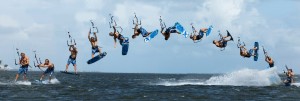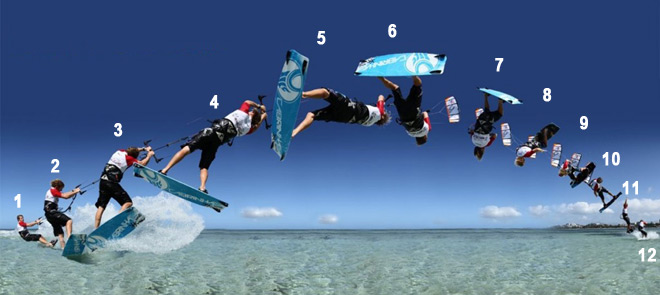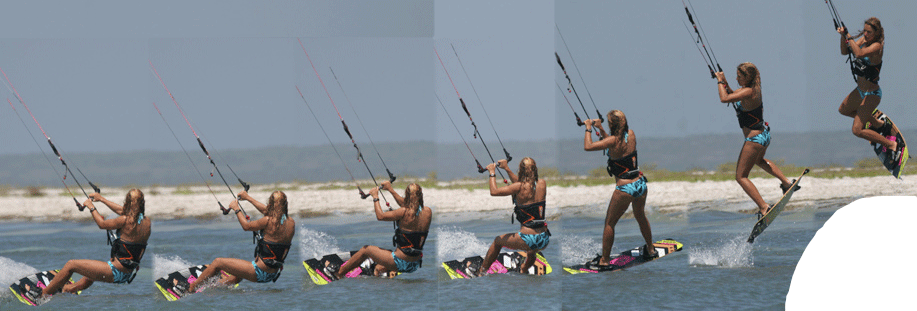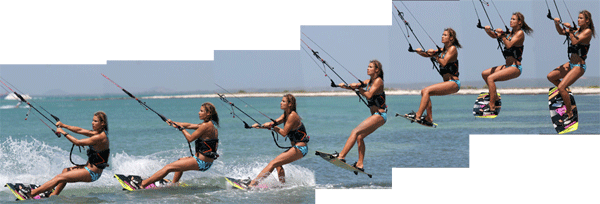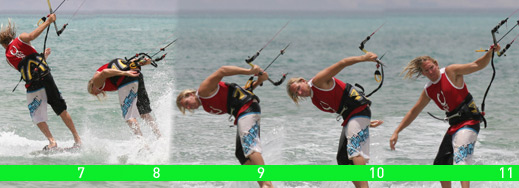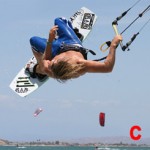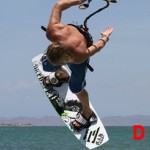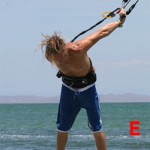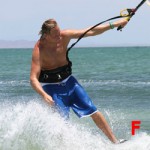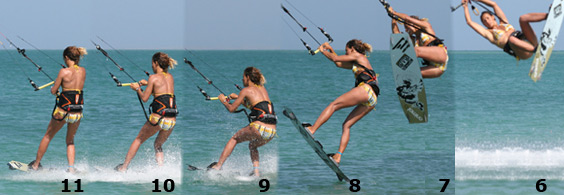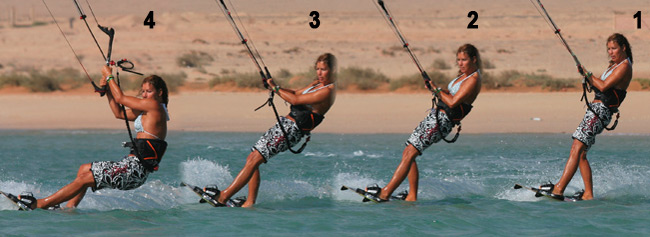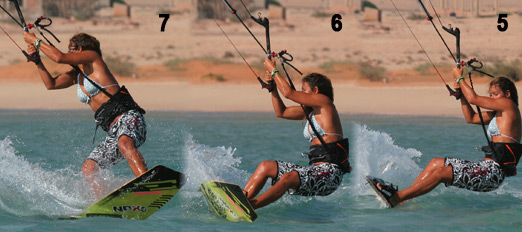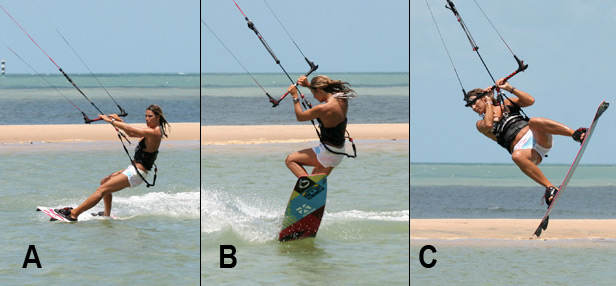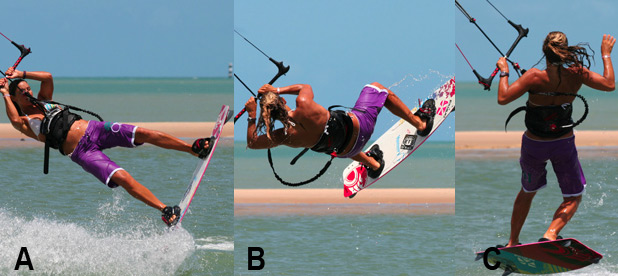Kite Loop

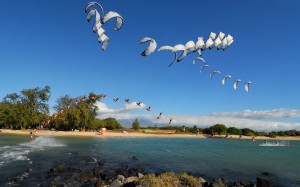 The kite loop is an extreme kite trick and you really need big balls to even dare try to perform this insane trick! As an “advanced” kite surfer this is however a trick you most likely will try to perform at least once! If you’re unlucky you might hurt yourself quite bad and will probably not be so keen on trying again! So a good theoretical knowledge about this crazy trick is an advantage before you try to do it practical. Follow this guide and you minmize the risk to crash, but first some ground rules.
The kite loop is an extreme kite trick and you really need big balls to even dare try to perform this insane trick! As an “advanced” kite surfer this is however a trick you most likely will try to perform at least once! If you’re unlucky you might hurt yourself quite bad and will probably not be so keen on trying again! So a good theoretical knowledge about this crazy trick is an advantage before you try to do it practical. Follow this guide and you minmize the risk to crash, but first some ground rules.
- Make sure that you are over powered to the limit using a relative small and fast(!) kite, 5-9 m2 is ok. I use a Royal Era though most new kites are fast enough.
- Be sure that the water is deep enough to not hit the bottom in case you crash.
- It’s best to start doing kite-loops with longer lines, don’t go below 20 meters during your first attempts to make kite loops.
- Have a stand by rescue buddy within reach!
Ok, so the preparations are done and it’s time to loop! Follow these steps:
- Jump as high as you can and when you’re just about to reach the peak, twitch the bar’s back side (if you going left, pull the right side)
- The kite will pass twelve and begin to loop.
- As the kite is about 270 degrees through the loop you will eventually start to fall and the lines might slacken a bit. Now don’t freak out. As you fall the lines will apperantly become stretched again and you´ll now be able to fulfil the last 90 degrees of the loop and the kite will catch you again.
- When it comes to landing, point the board fully downwind!! You´ll land with high speed and will not be able to land with your board pointing a upwind. Doing this can result in a twisted knee or two. Looking over your back shoulder as you loop will help you twist your hip and get you prepared for a landing with the board pointing downwind. Also avoid land on choppy water.
- That’s it! If you done everything correctly you should now be back in the water in one piece!
Good luck and don’t underestimate the use of safety equipment when you´re doing kite loops! Helmet and impact vest can save you months of boring rehab!
KGB
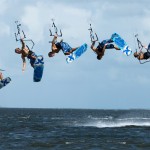
Don’t ask me where the name comes from… I can’t see any similarity between KGB and the russian intelligence, but whatever, here is the guide to perform the trick =)
- Come into the trick like you would do for an unhooked backroll. Unhook, edge hard and pop out of the water.
- Look over your front shoulder and go into a backroll rotation. When just over 1/2 way through your rotation throw your head in the other direction over your back shoulder and pull your hands hard to your front tip.
- Pass the bar from your front hand to your front hip.
- Once you grab the bar, reach around with your other hand and get them both on the bar.
- Spot your landing, bend your knees and ride away.
Tips! When unhooking always keep your elbows bent, this helps you keep a good edge. Try not to lean forward when you unhook. Keep your hands in the middle of the bar. Don’t throw the backroll to hard, it makes it hard to change direction.
Front to Blind
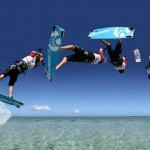
Our front loop love bubble wouldn’t be complete without adding the awe-inspiring blind landing a cheeky surface pass out. Tricks to blind looks phenomenal, feels sensational, and once you get the hang of landing blind; they will all start to be seen in your family of tricks.

THE KNOWLEDGE
You will need to get this move sorted in your head before you go and play. In theory, it is one and a half front rotation, but if you attack it like this, it will be much harder for you to land. To get the control and therefore consistency out of this move, you must consider it for what it is – a front loop, but then in preference to landing on a flat board off the wind as normal. Here are the two parts to perform this trick perfectly without you getting in a midst of nowhere.
CONTROL
No matter what move you’re attempting to blind, the key is having the move consistent so that you know how much rotation, how much speed and height you will have. If you practice your popped front enough, it will eventually feel natural to the point of the landing always being predictable. This way you’ll be able to think ahead, seemingly giving yourself time, and get yourself ready for a blind reception.
THROWING IT LATE
Landing blind in most situations is all about “throwing it late”. That’s to say you go for the twist to blind just before you land. If you try and go blind up in the air, there is a little chance of holding that position on the way down. The answer is to wait until you think it is almost too late, and then go for it. As you can see this will be difficult without having the rotation that you expect.
TWO HANDS ARE BETTER THAN ONE
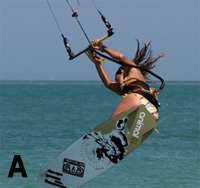 You may all want the style of some good surfers but you will have to build up to that. If you have been practicing your pop to raley to blind, you’ll notice that you are using your both hand t pull the bar in to rotate your blind. This gets the bar nearer to you, swings you towards the bar and in the front loop variant will stop you over-rotating. Admittedly doing it all one handed may look like “da bomb”, but it will be much harder, so get a grip. See pic A.
You may all want the style of some good surfers but you will have to build up to that. If you have been practicing your pop to raley to blind, you’ll notice that you are using your both hand t pull the bar in to rotate your blind. This gets the bar nearer to you, swings you towards the bar and in the front loop variant will stop you over-rotating. Admittedly doing it all one handed may look like “da bomb”, but it will be much harder, so get a grip. See pic A.
In this phase you are in the “throwing it” phase. You need to pull the bar towards you with both arms and it should be twisted already quite far around, you need to let go of your back hand followed by your body and twist all the way.
TWIST AND SHOUT
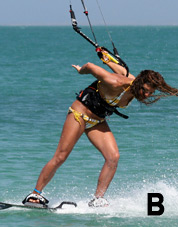 You are in the final phase now; this move is getting your body around to face the right way once you have landed. This will give you balance as it will stop you edging against the kite on your toes and it enables you to pass the bar. Like the surfer in pic B You should twist your left hand during the landing so that your thumb is pointing in the way you should go and this also will turn your shoulder more, then turn your head and look where you should go, which in turn puts your weight onto your heels and slackens the kite lines as you steer down towards the kite. It also puts the bar in place for you to reach up and grab it.
You are in the final phase now; this move is getting your body around to face the right way once you have landed. This will give you balance as it will stop you edging against the kite on your toes and it enables you to pass the bar. Like the surfer in pic B You should twist your left hand during the landing so that your thumb is pointing in the way you should go and this also will turn your shoulder more, then turn your head and look where you should go, which in turn puts your weight onto your heels and slackens the kite lines as you steer down towards the kite. It also puts the bar in place for you to reach up and grab it.
FRONT TO BLIND – ALL IN ONE!
1-3. Carv hard upwind against the kite to get enough lift and time to rotate. Position the kite at about 11 o´clock. If you put it closer to 12 you´ll lose your forward momentum and drop in the water without power. Position the kite lower around 10 o´clock and you´ll land with speed, eventually with too much speed!
4-5. Rotate and extend and turn your head to start spot your landing. Also don’t pull to much on your back hand since this will get much harder to perform the handle pass if the kite is to high.
6. Your are now in the same position as you would be in a simple front roll. Focus on where you will land and force your hands, the control bar and the rest of your body around as if you´re preparing for for a downwind land.
7. Now it´s time to throw the bar. Pull the bar towards you and twist your hip, legs and board further. Pull the back leg up towards your bottom and extend your front leg. This means that even if you land across the wind, the board will pivot under your right foot and end up further off the wind. If both legs are straight you will just hit the water and stop.
8. As you land make sure that your weight is on your right leg to allow the board to pivot further off the wind (of course your right leg will be the left leg if you rotate in the other direction as the surfer in the picture below).
9. Twist your hand and point your thumb in the direction you´re going.
10. Turn your head and shoulder even further
11. The turning will put the weight on your heels and take the tension of the lines, so you can bend over and get the bar nearer your back.
12. Pass the bar without and double-jointed contortionist skills =)
TOP TIPS
Whilst steering, try not to have too much speed, as landing a fast blind is a challenge for you.
KEYSTONES
1. Carve hard to go up.
2. Get enough height and time for the rotation.
3. Use both arms.
4. Let go of the body during the “throwing it” phase to rotate.
5. Throw it late.
6. Look where to land.
7. Control your twist after you land.
8. Twist and shout!
Some videos:
Front To Blind – Wakeboarding
Or why not add an extra front roll like Mike Blomvall and you´ll have a 720 Front To Blind
F-16
F-16
WHAT IS THIS, AN AIRFORCE JET PLANE?
No, the F-16 is a fundamental nature of an unhooked back loop kite loop, a kite loop being when the kite is hurled against the direction of travel.
Its core difference from the hooked in version, or in fact the purest unhooked version is the way that you hold the bar. As we shall see both hands will be grasping onto one side of the bar, which forces the kite to turn extremely fast. This in turn means that there is very little input from the surfer once it’s all begun, and that the kite will not produce g-suit necessitating forces. A real grin and bear it move, which is well within the reach of anyone who can back loop kite loop and unhook.
ANGLING
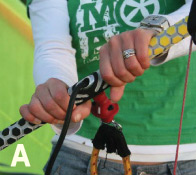 Pic A. Here we can see that the surfer is holding the bar with both hands centered in normal position riding to the right side.
Pic A. Here we can see that the surfer is holding the bar with both hands centered in normal position riding to the right side.
Now the surfer has two options, and it is up to you to see which you use. Knowing that you will need to get both hands on the back of the bar, you could either:
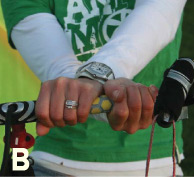 Pic B. Leave your back hand
Pic B. Leave your back hand 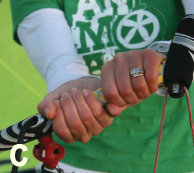 where it is, let go of your front hand and move it.
where it is, let go of your front hand and move it.
Or Pic C. move your back hand down to the end of the bar, release your front hand and grab the bar just the other side of the chicken loop in front of your back hand also with your palm facing up.
Both of these procedures work, although the first one necessitates less movement. Grab your bar and straighten your arms above your head to see which feels most comfortable.
THE KITE
The kite is very much dictating what is happening in the F-16. It will pull you up, it will rotate you and it will softly drop you back down once it finishes the loop.
It is very vital to trim your kite with the center line adjustment strap so that you are in control. Bowsexuals could leave a little more power in the kite as they do tend to turn quicker.
Doing an F-16, you will need to aim and position your kite very close to 12 o’clock above you. Like other powered techniques, starting while traveling slightly downwind will help. For the F-16, there are two grounds for this, other than the fact that it will be easier to unhook.
Firstly, once you have unhooked, if the lines are not completely tight, the kite will not move swiftly as you change your hands. This is very important especially on small kites.
Secondly, you need to do the whole rotation in the air. Most of us are used to doing the first half of a back loop by carving big time into the wind, which means that we’re already turned 180 degrees before taking off. If we do this for the F-16, we will overdo the spinning process. By cruising slightly off downwind, it allows us to carve for pop without turning too much into the spin.
THE YOU
The other main ingredient to a successful F-16 is an early take off. If you wait until the kite pulls you off the water, it will already have turned too far, and therefore pull you around too early, making landing a little wobbly or leading to a bad case of over rotation.
The best thing to do is to physically jump up into your back loop off your edge just before you think the kite will pull. By doing this, you’ll aim to finish half the spin. If you can look upwind while being at the peak of your jump, the kite will take over and bring you around for a nice soft landing. However, this may take a bit of practice to get the timing.
REAL TIME
The approach for the following sequence is identical to that of the down loop s-bend. Having had a very good look around to check that the coast is clear and that you have provided yourself miles of space downwind, slowly hurl the kite up towards 12 o’clock, flatten the board off to bear off the wind slightly and unhook. As soon as you have unhooked change your hands.
1. Once the hands have moved, it’s time to get back on your edge so that you’d still have some power to pop off. Do this by dropping your weight low and getting your shoulders out and upwind of the board. The bar is now vertical, this will happen automatically.
2. Just before the kite pulls, carve hard bending the rear leg ready to pop upwards. Your head should be looking forward in an effort not to create too much rotation.
3. Pop off; jump up across the air powerfully. Keep your head equally close to your shoulders. Your aim is to do half a back loop.
4. The kite has now travelled far enough behind that it pulls up.
5. As the kite starts looping, the power will extend you. The turning of the kite should pull you around.
6. When you feel the power collapse, look over your shoulder and locate a landing spot.
7-9. Remain focused on where you expect to land. The kite will have little power, and as a result, you will drop back towards the water surface. Grab and pull the bar in towards your hips to get your legs back underneath you.
10. With your legs dropping underneath, try and focus on pointing the board downwind.
11. On landing, try and maintain your weight over the back of the board.
12. Review where the kite is. If it is not travelling forward, let it continue to loop until it is, then release you upward facing palm (original front hand), place it back on the front of the bar and then hook in.
BEST TIPS
A speedy approach will make the pull from the kite seem far less violent while it gives you more control and a smoother landing.
If the bar is getting ripped out of your hands, try not to edge too hard for too long. Go downwind a bit more.
Try to imagine the F-16 as a game of follow the leader. As the kite loops you, just follow it around one step behind.
Dropping the back hand as you come down can help slow down the spin and also makes a speedy landing a whole lot easier.
If you keep on over rotating without getting any height, try not to throw a back loop, but ease into it by jumping up.
The more power you have in the kite, the higher and harder you will go. Just take it easy when learning.
This is how it should look after some practise 🙂
Front Loop to Wrapped
Front Loop to Wrapped
This is a blind move for any aspiring freestylers. The “Front Loop to Wrapped” is an attainable pop move for anyone landing Shifty to Wrapped, also doubles your way to get into a non-inverted slim. Theoretically if you can perform a controlled unhooked front to toeside, then this move is just your step away.
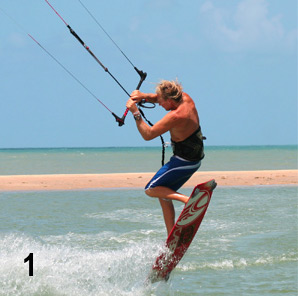 Pic 1 – From a front loop to toeside, you can see that the surfer has carved a long way upwind before popping. The result of this is that, regardless of how hard the fronts roll initiation it will have a stalling rotational speed effect at the start for the surfer to pop up into the rotation if needed. In short the surfer’s hands, bar and even the board are the way to a 360 degree rotation.
Pic 1 – From a front loop to toeside, you can see that the surfer has carved a long way upwind before popping. The result of this is that, regardless of how hard the fronts roll initiation it will have a stalling rotational speed effect at the start for the surfer to pop up into the rotation if needed. In short the surfer’s hands, bar and even the board are the way to a 360 degree rotation.
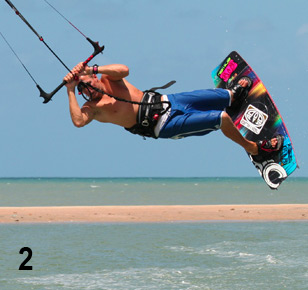 Pic 2 – You can see that the surfer’s head and shoulders have all but completed rotation. The legs however are trapped in a time warp and are following some way behind. The point here is to forget your legs and as long as you are ready for the landing with your head and shoulders, the board will drop down toeside.
Pic 2 – You can see that the surfer’s head and shoulders have all but completed rotation. The legs however are trapped in a time warp and are following some way behind. The point here is to forget your legs and as long as you are ready for the landing with your head and shoulders, the board will drop down toeside.
Building Blocks
Approach
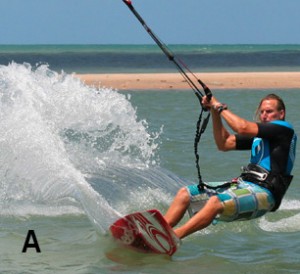 Pic A – This should be a familiar scene for many of you, as we are the usual ingredients for good unhooked pop. The surfer has the kite parked somewhere 10:30 and 11:00 o’clock and carving hard upwind with the bum low, shoulders, back and arms are bent slightly. The bent arms are is a must to do this trick. The surfer’s front leg are pretty extended with hips over the back foot and back leg resisting for preparation to pop off once carving into the wind is applicable.
Pic A – This should be a familiar scene for many of you, as we are the usual ingredients for good unhooked pop. The surfer has the kite parked somewhere 10:30 and 11:00 o’clock and carving hard upwind with the bum low, shoulders, back and arms are bent slightly. The bent arms are is a must to do this trick. The surfer’s front leg are pretty extended with hips over the back foot and back leg resisting for preparation to pop off once carving into the wind is applicable.
Take-Off
Pic B – During the take-off you need to keep your arms in close. Popping up will make this a lot easier. You will also need to get the kite where it should be as the chances are it will rise slightly during your carving stage. Here you can see the surfer has popped up hard off using the back leg with hands close to the bar. The surfer has also steered the kite down a little by pulling on using front hand, which also helps the initiation of the rotation combined with dropped front shoulder at the same time to turn swiftly.
Waiting
Pic C – This picture sums the move up and also demonstrates the similarity between a shifty to wrapped, shifty 3 and the front to wrapped. With the rotation on going, the surfer focused on where to land while feet are catching up but still behind position. The objective here is to wait until you feel that your feet are dropping down because that is the sign to go for the wrapped. Timing is very important.
The Pull
Pic D – As mentioned, you’re the dropping of your leg is the signal to go for wrapped. The reason is you will be using the momentum of your dropping legs to bring them through and up to turn to a wrapped. Once they start to fall – use them!
The surfer here has reaction to the legs because of both hand pulling hard and aiming to go past the right hip while bringing the back (right) leg up towards the bar. If the kite is too high, the lift will make the landing and passing difficult. When pulling on the hands, it is a good idea to give the kite a little tweak down because it can make the rest of the move much easier. As soon as the surfer’s back knee comes up, other knee is bent, turn head with the rotation and let go with front hand, thus allowing the surfer to turn with the momentum on going.
The Landing
Pic E – Your aim is to get the board at least downwind but preferably a bit further around, so that you will keep your speed and move towards the kite to make the pass out of wrapped much easier. Continue to turn your head to look where you should be going. In the picture, the surfer almost has too much weight back, which can lead to bouncing on landing. As you come down, even though you released your front hand, you should carry on pulling the bar behind your back with your back hand and twist your wrist. This will place the bar correctly, and it will wait obediently for the pass.

Step by Step Sequence Summary
1. The surfer bears off the wind considerably, unhooks, drops weight and starts to carve into the wind.
2. The surfer aims to carve a long way up into the wind and keeps the hands in close.
3. As the kite starts to pull, the surfer pops up hard by extending back leg with all might while pulling hands down towards the body.
4. The surfer initiates the rotation by throwing front shoulder down towards the water and at the same time dips the kite by tweaking it with front hand.
5. In this position, the surfer can now rotate the head around, looking back over the trailing shoulder which will guarantee him enough rotation to get the way around the first loop.
6. With eyes focused on where to land, the surfer waits, timed, and doesn’t try to land quickly then he brings the legs around through the landing position.
7. As the legs start to drop, the surfer pulls hard on both hands, trying to rip the bar past the back hip, at the same time bringing the knees up towards the bar.
8. The surfer releases front hand and turns the head while keeping the knees up. Remember to twist as this will make your body rotate much easier.
9. Coming in for the landing as you can see that the surfer has the bar and wrist turns and ready, he turns the head to try and look where to land giving weight forward over the board.
10. The surfer lands with the board facing slightly off the wind and the arms wrapped around behind.
11. All that’s left to do is to reach behind with your free hand and pass the bar. The further you rotate the quicker you will need to do this as you will have more tension on the lines and the kite will rise.

Tips to Remember
1. Edge hard upwind
2. Keep hands in
3. Pop up over your hands to rotate
4. Lead with head and shoulders
5. Pull both hand hard past your back hip
Air Gybe with Late Kite Loop
Air Gybe with Late Kite Loop
This technique is really much a cheat as it is a trick, and a very handy one. A late kite loop in this case means that the kite loops once you are on the water, not in the air. Perhaps you’ve already seen it many times before. The fact of the matter is when your kite control goes southward while altering direction in the air, doing this will provide you a nice bit of pull.
An upbeat outlook would predict several more advantages of combining this to the humble air gybes. It’ll give you the chance to hold them for longer and rack up the style points while still bursting with speed. On smaller kites, there is more chance of steering your kite too far behind and this yet against is a perfect answer. More retro pop transitions often result in you swinging away from the kite. Once more, this is the cure.
To cut it short, if you sometimes find your kite low and way to the side when you’re hoping to plane out of a transition, this trick will give you a handy boost of power right where and when you need it, and those days of sinking down will totally be gone. And finally, this can be an exceptionally comfortable way of building up yourself trust and skills in anticipation of a winner kite loop. Warning though, if you have never voluntarily looped your kite, we would strongly suggest learning the under turn first.
BIG POINTERS
As with any attempt to air gybe, it will still benefit you to try and get the basics right and add the late kite loop onto the end rather than try to apparently fluff it. We will be repeating ourselves to save you looking elsewhere.
Pic A.
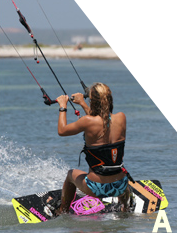 The surfer is about to take off and has approached with speed and kite not lower than 1 o’clock. To drop speed, you need to carve into the wind by putting weight over the rear foot, moving the hips towards the tail of the board and extending the front leg. The straight front leg keeps the board on its edge. The surfer has already steered the kite back aggressively and has the bar pulled into the spot where here back lines are tight. From this state, you can jump up off the back leg into the air gybe.
The surfer is about to take off and has approached with speed and kite not lower than 1 o’clock. To drop speed, you need to carve into the wind by putting weight over the rear foot, moving the hips towards the tail of the board and extending the front leg. The straight front leg keeps the board on its edge. The surfer has already steered the kite back aggressively and has the bar pulled into the spot where here back lines are tight. From this state, you can jump up off the back leg into the air gybe.
Pic B.
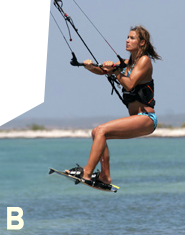 Now the surfer illustrates dropping back down towards the spot landing. You must be well balanced in this position. Have the board pointed off downwind by pushing your new front foot away while keeping the rear foot underneath. You need also to dive the kite hard to get it moving down in front rather than letting it drift slowly to the side. This way, it will pull you out of your free fall and get on moving as soon after landing.
Now the surfer illustrates dropping back down towards the spot landing. You must be well balanced in this position. Have the board pointed off downwind by pushing your new front foot away while keeping the rear foot underneath. You need also to dive the kite hard to get it moving down in front rather than letting it drift slowly to the side. This way, it will pull you out of your free fall and get on moving as soon after landing.
Pic C.
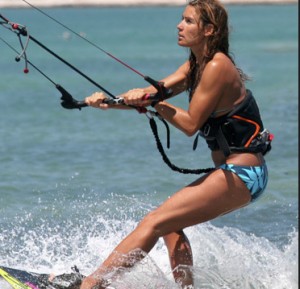 However, this is where it all changes from a regular air gybe to one with a late kite loop. Normally, assuming that you had dived the kite enough to ride away as soon as you land, you would be pulling hard on your new back hand in an effort to stall your kite crashing straight down into the water and turn it back up. Rather than steering the kite back up, continue to pull with the front hand, in fact pull even harder. This means that the kite keeps turning under itself and does not hit the water. As long as you keep pulling, the kite will start to rise and then turn forward in the desired path. To make this fun, keep the bar pulled in so that the kite continues to turn. Keep the board pointing off the wind and keep your weight back over the tail of the board.
However, this is where it all changes from a regular air gybe to one with a late kite loop. Normally, assuming that you had dived the kite enough to ride away as soon as you land, you would be pulling hard on your new back hand in an effort to stall your kite crashing straight down into the water and turn it back up. Rather than steering the kite back up, continue to pull with the front hand, in fact pull even harder. This means that the kite keeps turning under itself and does not hit the water. As long as you keep pulling, the kite will start to rise and then turn forward in the desired path. To make this fun, keep the bar pulled in so that the kite continues to turn. Keep the board pointing off the wind and keep your weight back over the tail of the board.
If you have another look at the video, you’ll see that the kite is diving straight down as if the surfer was landing an air gybe, but upon touching down, the kite goes under and around by pulling it a bit strong, dragging the surfer nicely along to the left side.
THE GREEN LIGHT
Once you’ve decided to do this, there are a few good ways of getting you warmed up. Firstly, practice a couple of under turns. If you’ll be going for this air gybing on your right, do the under turns on your left and vice versa. Now, you’ll be confident enough that the kite will go around.
Secondly, knock off a few air gybes and focus on diving the kite hard for your landing. If this feels comfortable, try watching your kite as it dives down. So basically, turning it one way or the other shouldn’t make any difference.
SEQUENCE 1
In these images, the surfer is using a 7m Nomad, which turns fairly quickly but won’t give her a massive amount of hang time. The surfer has the advantage of a kite that will loop with only a little positive input on the bar. But the disadvantage is that, the preparation for landing in a big chill position is cut short.
1. Making sure that there is no one at the back and could have more space to party. The surfer carves hard into the wind and sends the kite back. Weight back, front leg straight and bar close in.
2. As the surfer feels the kite starts to lift up, the next thing to do is to stop steering the kite back and places the bar at center parallel to the water. Still keeping the bar close in
3. The surfer then explodes up off the rear leg rather than waits for the kite to pull up, and pulls the bar right in – hands to hips.
4-7. Upon take off, the surfer tries to get the kite back above at 12 o’clock by keeping the bar level and keeping the tension on the lines by keeping both hands close and arms bent. Also the surfer starts to lift both knees up for stability. Now, it’s the big chill – keep this position up until the tip of your jump and wait until you drop.
SEQUENCE 2
1. As soon as the surfer feels like dropping, the surfer dives the kite hard with the new front hand, the left hand.
2. To make sure to have full control over the kite, the surfer keeps the bar in close, and thus has tension on the lines, so the kite will react whenever wanted/needed.
3. In readying for the landing, the surfer pushes the front leg forward and keeps the rear leg underneath. The scissoring of the board will point the board downwind. The surfer keeps sight on the kite as it wanted to be diving down.
4. Just before touching down, the surfer drops the legs to take the landing, the whole time the surfer has the bar pulled in and is still pulling on the front hand. Pulling off the can be of help to land downwind.
5. As the surfer lands, the board continues downwind. It would stop if you land on an edge, not ideal when the kite is about to generate more power. To compensate for any extra force, the surfer puts weight over the back and front leg extended.
6. Because the surfer has kept pulling, the kite has turned under itself and back up. Because the board is facing downwind, there is no abrupt pull, just a smooth acceleration out of the landing.
7. As the kite turns forward towards the new path, the surfer carves back onto the edge by pivoting the hips and shoulders further around to face which direction to go. The surfer also halts on pulling on the front hand, as another loop would be unnecessary.
USUAL PROBLEMS
There are several possible causes…
If you keep dumping the kite into the water while you land balanced and over the board.
- If you are not 100% committed to what you will be performing, looping the kite once you have landed, it is very tempting to let the bar out as soon as you feel a little pulling force from the kite, as it starts to turn under itself. Once you’ve released the tension from the back lines, even steering hard won’t keep the kite moving round. The answer is absolutely get some under turns and hard diving air gybe exits under your belt and then merge them up.
- You may not be actually steering the kite good enough. On larger kites, you may need to move what will be the new front hand towards the end of the bar to provide you the power to really pull the bar in.
- If you are landing with your kite unusually low to the water and to the side where you came from, and want to go back to it will not have enough room to turn under itself. The higher the kite starts the loop, the easier it will be.
If you find out that you are getting dragged off balance in the air.
- Chances are, rather than considering this as an air gybe, you’re more into super loop territory. Remember to get the kite back above you so that you’ll be in good terms with it at 12 o’clock. This way, the pull will come more from downwind and less likely from behind you.
- Timing is key. You need to be diving the kite at the same time you would for landing an air gybe just before touching down. If you pull too early, the kite will try and turn under itself while you are still up in the air, also known as kite loop which you can learn onto, but focus more on the late kite loop timely.
Lastly, if you are getting pulled onto your face when the kite loops, make sure you’re not edging against the pull AND put your weight back with your front leg extended.
KEY POINTS
- Edge then send
- Big chill
- Wait and dive just before landing
- Point board off wind, weight back
- Keep pulling with new front had
And the video…
Double Front Loop Down Loop Transition
One of the advanced level tricks in Kite surfing is the double front loop transition. This is tried by mostly experts or advanced intermediate surfers. The technique here is mostly based on how you balance your forward momentum on the board and then move to height and bring yourself down on the downward wind and this is where you try out the perfect rotation of yourself. So to approach this trick there are couple of steps you need to follow.
First thing you need to do is basically place yourself on the board. This is done with the right leg placed straight on the board with the left leg behind in such a way so that it is used for pushing the board. As the wind speed increases the kite will start to lift you up and this is the point you need to start rotating yourself. Make sure you do not bend the back legs from the board as this basically slows down the entire rotation obstructing the perfect transition. The main idea here is to take you up on the first rotation and slide down in front for a smooth landing but you will notice that by the time you finish the first rotation and shift your head on the other side you are again ready to go for the second time. The next step is here when you and the kite are lifted up and you need to stay at 12 o’clock to the kite all this time by controlling the kite bar with front hand pulling it in forward direction. Every time you jump up the kite should be at 12 o’clock position and this is done when you rotate the body but your feet should be on the board. The impressive part of this is when you are lifted in the air and try to come down it descends slowly and gives you a feel of the kite and its forward movement.
A point to remember here is the kite should be always above you during this time otherwise the downward loop will pull the kite in front and you will be away from it. Always remember that the downloop will be slow and steady so that during this movement it will land you and also has the force to pull you forward. In fact you do not need to make the whole 720° as the downloop which helps in the smooth transitioning to landing also takes care of the turnings. But this is different from kite to kite and it matters on the sizes. For instance if you are using a kite which is slightly larger than the common ones available then make sure the front hand which is over the bar to move in the forward direction to control the high speeds which is controllable with two hands in case the kite is smaller. As you move forward with the wind, you will soon realize that how the kite quickly understands where to downloop and the downwind along with it also assists you in landing your kite.
Back Loop to Blind
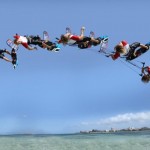
This moves shows an absolute control and beautiful trick in its own right, it is also the final building block to a couple of world class air pass moves. Once nailed you will be the envy of many at your local point, and it will spur you on with a new found confidence to try more technical tricks that not so long ago seemed impossible to reach.
THE BACK LOOP
First, your unhooked popped back loops need to be 100% accurate and controlled. By this we mean that you need to be executing a popped rotation at a slow pace. This will result in your land facing downwind. Such a back loop will also result with your landing with slack lines with no pull from the kite and a feeling that you’re actually dropping down. To achieve this, the three things to remember are the head position, kite and the point of sail. Try not to use your head for rotation, just look forward where you are going to take-off and leave your head square with your shoulders.
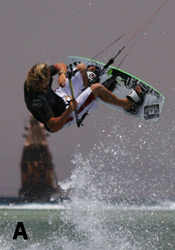 In picture A, the surfer is coming around his rotation but isn’t
In picture A, the surfer is coming around his rotation but isn’t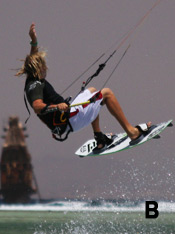 looking over his shoulder. This way you’ll not suddenly be round and landed, but will have that split second to think about throwing it to blind. You need to have the kite a tad lower than your usual measure. If it is 11 or 1, you will be less likely to spin under the kite and there will be something to pull against to get your knees up and the rotation to blind starts as in picture B. You can see the surfer is really pulling his knees in before throwing to blind.
looking over his shoulder. This way you’ll not suddenly be round and landed, but will have that split second to think about throwing it to blind. You need to have the kite a tad lower than your usual measure. If it is 11 or 1, you will be less likely to spin under the kite and there will be something to pull against to get your knees up and the rotation to blind starts as in picture B. You can see the surfer is really pulling his knees in before throwing to blind.
Where you take-off is where you land. So if you want to land more downwind, you need to take-off more downwind. The real advantage of this is that if you start your back rotation in the air, sometime before the board passes through the wind; your brain has time to react and ponder the blind a bit. If you take-off into the wind, you will be able turn around before you have time to pull.
So once again before attempting a back to blind, hammer out back loops to get the first part automatic!
THE BLIND
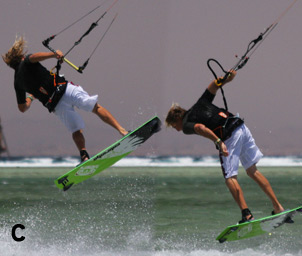 The blind in the Back loop to blind is made more difficult than a front to blind because it is by the fact that not only you are throwing to blind, but you actually have to break your rotation and turn the other way. In the raley, your body is trying to twist the wrong way so it should have trained you in a certain level.
The blind in the Back loop to blind is made more difficult than a front to blind because it is by the fact that not only you are throwing to blind, but you actually have to break your rotation and turn the other way. In the raley, your body is trying to twist the wrong way so it should have trained you in a certain level.
As mentioned already, your head, kite and point of sail will be crucial here. By not looking for your landing over your shoulder, you’ll find it easier to change the direction that your body is travelling in. With the kite lower, your feet will be higher and your body will be in a horizontal position sp you can pull against the bar to stop the initial back rotation and go the other way around. And having taken off earlier, you can rotate more slowly which in turn means that there will be less momentum to fight against.
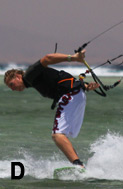 Do not forget to turn your head and twist your wrist, pointing your thumb at where you are going as in picture C. This will help your shoulders turn further, enabling you to turn the board further and stick a more downwind landing with the bar in the right place (picture D) to grab when you go for the surface pass.
Do not forget to turn your head and twist your wrist, pointing your thumb at where you are going as in picture C. This will help your shoulders turn further, enabling you to turn the board further and stick a more downwind landing with the bar in the right place (picture D) to grab when you go for the surface pass.
Once you have mastered a load of back loops, do the same with several raleys to blind and then you will be ready!
SHOWTIME SEQUENCE
Following the sequence which is relatively low and in very light wind will give a good way of confidence. Do not forget to make sure your leash is on the correct side.
pic 1 – The surfer come up over the board flat off and unhooked knowing that the coast is clear. His kite is around 1 o’clock and his hands are together in the middle of the bar.
pic 2 – From a broad reach the surfer carves hard against the power in the kite, front leg extended and back leg flexed and ready.
pic 3-4 – As the board turns upwind, the surfer extend his back leg and pops up. The surfer also keeps his arms bent as this will make the pull in for the twist to blind much easier.
pic 5 – Due to the pop and the kite position, the surfer is pulled into a more horizontal back loop.
pic 6 – As the surfer comes around the back loop, the board is behind and up in the air, almost where it would be during a raley. This is the moment to throw the blind and later on you will miss the chance as the board will start to drop.
pic 7 – The surfer pulls the bar hard towards his front hip to initiate the twist to blind. If the kite were much higher, this would be harder as it would not turn. At the same time the surfer turns his head in the opposite direction and keeps his knees up.
pic 8 – To make sure, the surfer turns far enough and looks around towards the direction of travel.
pic 9 – The surfer will then be able to turn his thumb down and forwards, twisting the bar which moves the shoulders further around, therefore allowing the surfer to get his upper body low.
pic 10 – So now an arc has been created, the surfer can easily pass the bar behind the small arc of his back.
pic 11 – And finally, the surfer turns to face the new direction of travel and sort it out.
Here´s what it will look like when you master this trick:
Downloop S-Bend
We are throwing this just in time for those winter gusts and/or trips abroad. We have noticed quite a bit of a down looping this summer and this is a fairly simple add-on. The move opens up a plethora of possibilities down with super power up. It can deliver some serious arching height and looks great off a wave and is a real crowd pleaser when thrown to blind.
THE DOWNLOOP
The kite downloops when it is sent with the direction of travel by being somewhat aggressive on the front hand side of the bar. It is best to start with the kite at 12 o’clock position.
THE S-BEND
An S-BEND is the most effective way of completing a pop forward rotation when powered up. The primary difference between this and a standard front loop is the take-off. When learning the front loop, we usually throw our head and front shoulder down towards the water, bending and folding in the process as if we were role-playing. Because we have sent the kite, it gives us the necessary lift.
THE FULL MONTY
Like many moves, your first attempts at this are best when you are not clinging onto your bar. Larger kites will give you more lift and time; smaller kites will give turn more quickly, so middle of the road relative to your weight would be ideal. The key to down looping is the timing, more precisely going early.
GO FOR THE GOLD (sequence)
- The surfer carves the kite and starts to move forward. In anticipation, the surfer has compressed his legs to get ready for the launch. The surfer is not waiting to get ripped off the water by the kite, but instead explodes upwards as soon as he feels the kite begins to pull. Up to this phase the surfer could also be going for a straight down loop. (The only difference being that as the rider jumps, he will look over his hands towards the kite for balance and prepare for a downwind landing).
- As the kite starts to pull, the surfer stamps down on the back leg and throws him upwards, literally jumping into the air.
- To initiate the rotation, the surfer has thrown his trailing right shoulder up.
- The kite is now generating a fair amount of pull as it turns good top to toe stretch. This is real commitment time, just hold on and enjoy your flight.
- The kite continues its journey and the yank will in fact pull the surfer around the rest of his rotation.
- The surfer’s only effort is to twist his head and search for the landing strip.
- Once this kitesurfer sees the water, the rest of the body follows suit, the completion of the S-BEND bringing his feet back underneath. If at this stage you feel you still have some height. It is time to let go with the original back right back hand to help slow your rotation and balance the landing.
- On touchdown, the surfer absorbs the impact with soft knees and once they have recovered, the surfer grabs the bar again with the back hand, sails on downwind to hook back in and giggles blissfully.
PROBLEM YOU MAY ENCOUNTER
Ideally, as you land you’ll see your kite once again diving down towards the sea. That means that you can grab the back of the bar and pull the kite out of its dive posture as you hook in.
There are 2 Reasons why the kite does this.
First – If you edge for your country and wait for the kite to physically rip you off the water, the kite will almost have finished a complete loop before you get airborne. To correct this, just think about going early. By this we mean swap your hands, carve and jump up. You should then get the pull in the air, a slower rotation, more height and a sweeter landing.
Second – You are riding in a tiny kite.
TOP TIPS
If you are having trouble finishing your rotation, try starting with the kite higher. It is fairly unnatural to stick the kite at 12 o’clock.
More power in the kite should give you a slower rotation but a more preferred gun blazing downwind strike.
Once you are confident, try using more power. That is to say do not pull the trim strap as far down as you usually would for and unhooked move.
Here are some videos of this kitesurfing trick
Front Loop Kiteloop
This is a stunning move for those that really like ballsy tricks where it is all about setting up everything perfectly. Before going through the move, it is encouraged to simply “go earlier” and “pull of your life”, stepping it up a gear so you get focused on the move. This trick is all about commitment, once you have set the wheel in motion, you are a whole lot better off going the nine yards than trying to make your way out. The good news, however, is that you can build up into this trick and therefore save yourself onto any unnecessary spankings.
To give yourself a good chance of nailing the front loop kiteloop, there are definitely a few things that you should be able to do. Due to the fact that you’ll be looping forwards whilst the kite loops backwards, you will perform this move blind, as all the action will be happening behind you. The base for learning this move is a front loop transition, so this needs to be solid. On top of that, this shouldn’t be the first kiteloop you are attempting, as you really need to have your fast and sometimes hard and difficult landings down.
FIRST STEPS
To get your head around the idea of what is going on we will start at the front loop transition. Normally as you exit the transition, you should dive the kite hard. This pulls you out of your rotation and encourages you to land downwind. Essentially this results in the kite diving straight down through the window, and it usually takes a fair old tug to stop the kite from hitting the water. It is then when you carve back onto your edge and the kite rising which takes you back in the other direction.
Once you done a few front loop transition and feel comfortable with the approach. As you exit the move, just as your board touches down pointing off wind, rather than pulling the kite back up, pull harder with your back hand so that the kite loops under itself. This way you will follow the pull of the kite and carve out in the same direction that you went into the move, so no change in direction.
THE APPROACH
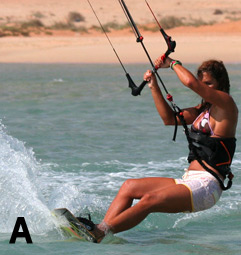 Pic A – Shows the surfer just before the take-off. If you look at her hand and the bar, you can see that the surfer has sent the kite back, but jump is not that aggressive. There are two reasons for this. First, you do not want to be jumping high because this move is all about commitment, make it easier to commit. Once you are three meters up, you may find the thought of looping your kite-less appeal. Second, you do not want your kite to go too far behind you. The further back it goes, the lower it will loop, which in turn means a heavier landing. Apart from the gentler sending, much as transition, the surfer is still carving hard against the kite off his back foot and dropping his weight against the upward pull of the kite.
Pic A – Shows the surfer just before the take-off. If you look at her hand and the bar, you can see that the surfer has sent the kite back, but jump is not that aggressive. There are two reasons for this. First, you do not want to be jumping high because this move is all about commitment, make it easier to commit. Once you are three meters up, you may find the thought of looping your kite-less appeal. Second, you do not want your kite to go too far behind you. The further back it goes, the lower it will loop, which in turn means a heavier landing. Apart from the gentler sending, much as transition, the surfer is still carving hard against the kite off his back foot and dropping his weight against the upward pull of the kite.
TIMING
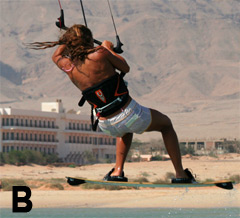 Pic B – The surfer is most definitely rotating into a front loop. You can see how far his front shoulder dipped still down from the take-off and that the surfer has already brought his legs up for balance and speed of rotation. However, the really exciting part of this picture is the bar. His back hand has slid all the away to the end of the bar, so the surfer can get decent purchase to crank the bar in and get the kite turning into its loop. It is also worth noting that the surfer has not pulled his front hand in. It is very easy to pull hard on the back hand and subconsciously pull down on the front hand too. Just keep the bar sheeted in with the front hand and let the back hand/arm do all the work. When learning this move, the harder you pull on the bar and the quicker the kite turns the gentler the kiteloop will be. From here there is no way back.
Pic B – The surfer is most definitely rotating into a front loop. You can see how far his front shoulder dipped still down from the take-off and that the surfer has already brought his legs up for balance and speed of rotation. However, the really exciting part of this picture is the bar. His back hand has slid all the away to the end of the bar, so the surfer can get decent purchase to crank the bar in and get the kite turning into its loop. It is also worth noting that the surfer has not pulled his front hand in. It is very easy to pull hard on the back hand and subconsciously pull down on the front hand too. Just keep the bar sheeted in with the front hand and let the back hand/arm do all the work. When learning this move, the harder you pull on the bar and the quicker the kite turns the gentler the kiteloop will be. From here there is no way back.
KITE CONTROL
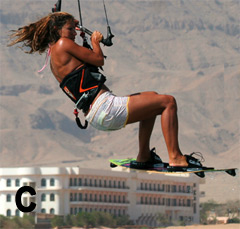 Pic C – To be in control of the kite and make sure it loops, you need to have tension on the lines. Here you can see that the surfer has the bar sheeted in, so the kite will react. Also by making a physical effort to keep the bar sheeted in, you are far less likely letting the bar slide out as the power comes on, which would unfortunately stop the kite from turning. An added bonus is that, as the looping kite pulls, you will feel it through your arms, not just your harness and thus, you will able to keep your balance more easily.
Pic C – To be in control of the kite and make sure it loops, you need to have tension on the lines. Here you can see that the surfer has the bar sheeted in, so the kite will react. Also by making a physical effort to keep the bar sheeted in, you are far less likely letting the bar slide out as the power comes on, which would unfortunately stop the kite from turning. An added bonus is that, as the looping kite pulls, you will feel it through your arms, not just your harness and thus, you will able to keep your balance more easily.
COMMITMENT
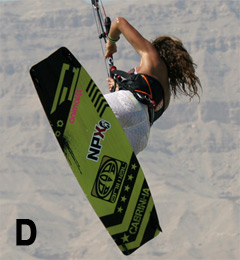 Pic D – The surfer has been pulled around his front loop by the looping kite and the pull of his harness hook. As long as the kite loops, you will always finish your rotation. Even though she is around, if you look closely, the surfer still has the bar pulled right in with both hands thus giving it plenty of hand. It is tempting to ease off because it will feel like the kite has turned further than it really has, but if you do, the best end is the splashing down in like a doggy transition. The surfer is also looking where to go. As a reference, try to look slightly behind of the downwind, this way you can land with speed and then carve out, and if you have looped the kite too fast, you can carve back from where you came, having turned the whole thing into a front loop kiteloop transition.
Pic D – The surfer has been pulled around his front loop by the looping kite and the pull of his harness hook. As long as the kite loops, you will always finish your rotation. Even though she is around, if you look closely, the surfer still has the bar pulled right in with both hands thus giving it plenty of hand. It is tempting to ease off because it will feel like the kite has turned further than it really has, but if you do, the best end is the splashing down in like a doggy transition. The surfer is also looking where to go. As a reference, try to look slightly behind of the downwind, this way you can land with speed and then carve out, and if you have looped the kite too fast, you can carve back from where you came, having turned the whole thing into a front loop kiteloop transition.
LOCOMOTION SEQUENCE
1. Approaching with speed, the surfer has a good check to see the room to get pulled back and downwind by looping the kite without risking anybody else. The surfer got a bit of water under too. The surfer sends the kite back positively, keeping the bar on the sweet spot.
2-3. As the front loop goes, the surfer throws himself forward and down as the kite lifts him up off the water. At this point the surfer levels the bar and sheets in.
4. As the surfer starts to rotate, sliding the back hand down the bar and pulls his knees up and then pulls hard on his back hand to get the kite looping.
5-7. To increase his chance of success, the surfer keeps pulling on his back hand to make sure that the kite turns all the way and also keeps the bar pulled in, so that there is tension on the lines and the kite does what the surfer expects.
8. So far all through the rotation, the surfer has been looking over his back shoulder. As the surfer gets most of the way around the loop and focuses on where to land.
9. With the kite powering around its loop, it spins the surfer around so that his harness hook is pointing at where the pull is coming, slightly behind of downwind. The surfer keeps the bar sheeted in and keeps turning the kite with his back hand.
10. This is the moment of most power as the kite starts to climb back up. The surfer keeps his knees up thus, pulling the bar with his hands to keep the balance.
11. The surfer has survived the loop and just need to stick the landing. With the power of the kite decreasing, the surfer starts to drop. This is his cue to let his feet drop beneath.
12. As his feet drops, the surfer aims for a downwind landing, concentrating on keeping his weight over the board and not to one side or the other.
13. The surfer lands tail first but onto a level board, so the surfer can soak up the speed. Once steady, the surfer carves back onto his edge, with a great relief plus the applause.
KEYSTONES
- Keep bar in to sweet spot on take-off.
- Move back hand down the bar.
- Start kiteloop as soon as you feel you are rotating under the kite.
- Keep both hands on the bar and keep the bar in.
- Look to land downwind over the board.
Here is a video of this trick
Backloop to Blind with Air Pass
To learn this move you need timing and technique because the air pass on this trick is dependent on it, not on brute strength, it is within reach. But, i if you dangle your thrusting hips, it will serve you proud! Also, we will look at this trick as a stepping stone towards the much cooler named KGB.
REPETITION
A good starting place is to go back to the popped back loop, as you’ll need to give yourself time, some extra height and changing of rotation in preparation of throwing in a cheeky air pass.
Once again you will need to practice a slow rotation, so the two reminders to remember are:
1. Where you take-off is where you land (downwind to downwind). So bear off the wind a lot before taking off. This way you will do more of the back loop in the air than on the water, which in turn will give you time to prepare for the pass and reward yourself with and easier stick downwind landing.
2. Mind your head. If you look around over your front shoulder as you take-off, you will spin much faster, so aim to keep your head square with your shoulders and look through the gap between your arms. Not only will this slow down your rotation, it will also make your direction change easy against the flow when you throw the pass.
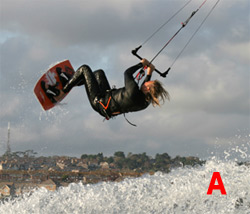 As far as your rotation is concerned, you will need to get more inversion. This does not mean you need to be upside down, but if you look at pic A you can see how the surfer is in a horizontal position and has his knees up above his body. This will stop his body dropping away from the bar when the surfer goes for the pass. The simplest way to get into this position is to lean your body back over the tail of the board as you pop, which will lay you onto your back in the air. As soon as you leave the water, make huge effort on bringing your knees up.
As far as your rotation is concerned, you will need to get more inversion. This does not mean you need to be upside down, but if you look at pic A you can see how the surfer is in a horizontal position and has his knees up above his body. This will stop his body dropping away from the bar when the surfer goes for the pass. The simplest way to get into this position is to lean your body back over the tail of the board as you pop, which will lay you onto your back in the air. As soon as you leave the water, make huge effort on bringing your knees up.
Try to keep your kite around 11 or 1 o’clock, as it will help you with the rotation, body position. It will give you something to physically pull against when you go for the pass much higher and you will be dangling under the kite, and also you will need that extra energy for that.
TIMING FOR THE GO
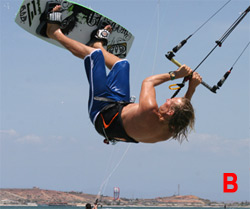 Pic B – we can see that the surfer seems much inverted compared to the previous. However, if you look closely, the only difference is that his feet are higher and his legs are extending, this means that the surfer is going for it. From practicing this trick, you should know the moment when you’re tucked up the bar is close to you and you start to drop down as you complete the back loop. You need to go for the pass just before the dropping time. To give yourself more “float”, kick your legs up just before you throw the blind twist. With the board up, momentarily no force will pull you down. You can see in this picture that the surfer comes further around the back loop and his hips are moving around towards the bar.
Pic B – we can see that the surfer seems much inverted compared to the previous. However, if you look closely, the only difference is that his feet are higher and his legs are extending, this means that the surfer is going for it. From practicing this trick, you should know the moment when you’re tucked up the bar is close to you and you start to drop down as you complete the back loop. You need to go for the pass just before the dropping time. To give yourself more “float”, kick your legs up just before you throw the blind twist. With the board up, momentarily no force will pull you down. You can see in this picture that the surfer comes further around the back loop and his hips are moving around towards the bar.
THROWING THE PASS
Once you have kicked your legs up and the board away, you’re throwing yourself to a blond, just from a rather familiar position. The actions are the same; you will pull hard on the bar with both hands and bring it towards your front hip.
Pic C – You can see that the surfer has pulled, released the bar with his back hand, and is now throwing his head, hips and shoulders around. This is really where the kite position is so important. If the kite is too high, there will be nothing to pull against, and you’ll find it hard to get the blind rotation.
Pic D – You can see how the surfer twists his wrist and thumb down and around, which enables his body to twist around further. Commitment is the key here. It would be very easy to give up and let go but you must reach around with your free hand. If the kite is sufficiently low, your pull before throwing should result in a tiny bit of slack as you drop and therefore making the pass easier.
Pic E –If you have timed it right, the bar will come to you, hopefully before your board touches down. Just let the kite pull our arm around and try to follow with your head for a balanced landing.
Pic F – Voila! When you watch someone doing a trick like this and it looks often effortless, take in mind that you need a complete conviction and your best kite face.
THE COMPLETE SHOW
1. With enough power in the kite and speed under the board to pop against, the surfer has unhooked, pointed off the wind and is now carving hard into his pop. His bum is down and front leg is extended for a decent edge whilst his back leg is slightly bent ready to explode for the take-off.
2. The board turns up and it is time to extend his back leg as the surfer leans back over the tail to initiate a more horizontal back loop. His head is looking forward to where to go for the rotation to slow down.
3. As soon as his board leaves the water, the surfer starts to bring his knees up towards his body. He is still looking straight through his bent arms.
4. Still going up and around, the surfer isn’t looking over his shoulder, but lets the back rotation bring his hips around towards the bar.
5. If you were to look at the bar, it has completed the back loop. However, the surfer will always be following. From practice, he feels the rotation around onto the bar, so it is time to go for it. The surfer kicks his legs up, pulls the bar hard into his front hip, thrusts his front hip up and around and throws the pass. Because the kite is low enough, the surfer has something to pull against to kick-start his blind rotation before letting go with his back hand.
6. Turning the body, the surfer twists the bar around behind his back, enabling him to turn even further and position the bar so that it is ready for his free hand as it reaches around.
7. As if by magic, the bar is where it should be and the surfer grabs it with his free hand, whilst simultaneously releasing his other hand.
8. Dropping down, the surfer lets his arms untwist and lowers his legs in preparation for the landing.
9-10. As the surfer comes in and looks around as to where to go he reaches up for the bar with free hand. Both these movements will help balance the landing. Then regains control of the kite with both hands on the bar and sails on smugly.
Here are some videos of this trick:
Back To Wrapped
This trick is a fairly funky move in in its own right, although you do not get to see them as much. Most riders skip it in preference of going straight into the back move, and once they land, then they are unlikely to go back to the wrapped version. However, if you’re not one of the better riders in the country, this is a very useful stepping stone which will satisfy and build a consistency for more progressive moves.
The beauty of the back to wrapped is that the momentum of a slightly over rotated back loop can carry you around to wrapped. Without stating the obvious, you will need a controlled unhooked back loop to toe side at the very least. If you are already popping to blind, then this will help. Even though blind is very different, having a natural bar pass will make life easier.
POP LATE
In many pass tricks, the difficulty is in slowing your rotation down. In this one you need to speed it up. The simplest way to do this is to carve your way up into wind before popping off your back leg. This late take-off will spin you faster and will send you into a second rotation, at least to toe side, without you having a moment’s thought. The only disadvantage is that you won’t have much time to prepare for the rest.
ELBOWS IN
When you carve into the wind it is more likely that your arms will be pulled out by the power in the kite. As soon as you leave the water, you need to get your elbows tucked into your side. If you can get them in, your hips will roll onto your hands, which keeps the bar in close and enables you to keep your balance and pass.
TWIST AGAIN
You need to rock your back knee in order for you to stay with the move. As you rotate with elbows pulled in, you will need to lift both knees. This will not only speedup your rotation but will also place your back knee high enough so you can kick it through. This knee force will accelerate your second rotation and will take you past the landing toe side. Remember to twist your wrist once you release the bar with your front hand as you will be able to turn your shoulders further. Once you get the hang of things, you can even pull your hands in and steer the kite down as you push through. This will bring everything together at your hips and helps keep the kite lower for landing, preventing it from pulling you out of position and off balance.
TOUCH DOWN
It is all good when you are through with all that leads, but it means nothing if you are not ready for the touchdown. To stick this you will need to get around to downwind preferably a bit further. To increase your chances you should try and land tail first, as the back of the board will then pivot you around a touch further. To make this possible, get your weight on the ball of your feet, not your heels, otherwise you will keep slamming. Finally, keep looking around so your body will turn to face your intended direction of travel and make the pass behind you considerably easier.
GIVE IT A GO
pic 1 – The surfer has checked for space, turned off the wind and unhooked, hands on the center of the bar with his weight over his back foot.
pic 2 – The surfer carves hard into the wind, dropping his weight low and resisting the power by driving against both heels, making sure to take the weight of the kite on both hands evenly to stop any unwanted kite movement.
pic 3 – The surfer has carved further into the wind than a normal pop would do. His head is turned to look right upwind over his shoulder. Also, as the board turns up into the wind and under the surfer, there is a little resistance from the edge so pulling his elbows back in has been started already.
pic 4 – When the surfer feels that there is less pressure on the bar and on her legs, the surfer quickly pops. This means that the explosion off her back leg will accelerate his spin. You can see that the surfer extends his back leg as it pushes him around as opposed to up into a huge pop. The timing here is very important, If you leave it too long you won’t even get enough height to complete a back loop.
pic 5 – Because the turning off so far on the water, the surfer is already three quarters around his back loop as soon as the rotation is in process. His aim is to keep his elbows in and bring his knees up making him smaller because this will help keep momentum going for the rotation to wrapped, and by lifting his knees, the weight of the board will not pull him down away from the bar too soon.
pic 6 – Coming around the back loop, the surfer’s trailing knee is up near the bar and his hands. As he continues to rotate, his hips will follow his knees and roll towards his hands. Once you have tried it enough to give your brain some time, this would be a good moment to jerk our hands in and even steer the kite down as you do so. At this point, the surfer must keep looking over his shoulder and around into the next rotation. If he were to focus on where to land, it will slow his spin and prevent him from getting around.
pic 7 – A split second before this shot, the surfer have really pushed his back leg and knee just as his hips rolled towards his hands. So he have done it with both hands on the bar to keep the kite from going up and allowing him to get hands and hips as close as possible. As the knee comes through, the surfer lets go with her front hand and keeps looking over his shoulder.
pic 8 – As the surfer turns, the wrist is twisted and the thumb pointed towards the small of his back. This enables him to turn further. He lands back foot first with weight on the ball of his feet. The board will pivot further around here without the surfer catching his heel side edge.
KEYSTONES
- Carve hard and long, lead with head.
- Elbows in.
- Knees up.
- Both hands to hips before releasing.
- Twist your wrist.
Here are some videos of this trick:
Aaron Hadlow shows how to make a back 2 wrapped
Konstantin Tuludis also knows how to make this trick
As well as Ariel Corniel
Unhooked Popped Front Loop
In continuation of out front loop fest, we thought it high time to introduce and familiarize the baby brother of the much respected S-bend, the Popped Unhooked Front Loop. Not only does this move dazzle, but also it is a foundation for a whole other world of kiting techniques that may or may not intrigue you. In addition to that, all this unhooked malarkey (if you’re tempted) is just as well practiced on those underpowered summer days, so give it a shot.
Popping, front looping and a basic unhooked Raley would be a small requirements, along with a modern safety system that lets you both spin and unhook without risking any third party members of the public or kite surfing community.
To help you learn all the important ingredients of an unhooked popped front, we’ll take another look at unhooking, a little glance at popping and way up the differences of popped front compared to a sent front loop.
DETACHMENT
The simplest way to make unhooking controllable is to understand how your kite is trim, thus your bar position will effect what’s going on.
For unhooking, it is vital that you use the strap to trim your bar’s sweet spot so that it rests just above the chicken loop. This way, the bar will feel light and the kite will drift forward, allowing you to be powered up yet in control. Every kite is unique, but it’s more time consuming getting it right. If you don’t trim the sweet spot down, your kite will most likely flare, pulling you off downwind, falling out of the sky in the calms and making kite surfing in general fairly unkind.
Pics 1 & 2. You can see that the surfer is sailing along hands centered with bar trimmed down, flattens the board off by abruptly standing up and almost carves, putting weight over the rear foot. This sudden change in direction towards the kite releases the tension off the lines.
Pic 3. With the tension gone, the surfer pulls the bar in and pushes it down to let the chicken loop slide out from the hook. Without looking down, as this would prevent the hips to move back and make unhooking difficult.
Pic 4. As the chicken loops drops out, the surfer must start to carve into pop before losing speed. Head positioned forward in direction as to where the surfer wishes to go, moves weight and hips right back over the rear foot and straightens the front leg, while dropping upwind off the board to get it back on an edge.
Pics 5 & 6. The surfer tries to maintain shoulders, back and front leg straight when carving hard against the pull of the kite. The goal is to explode up off the rear leg once it gets unstable, must also try and maintain equal pressure on both hands, as it is easy to pull on the back hand and hurl the kite up.
HANDS OF TIME
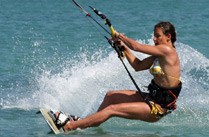 It is essential that you provide a good pop, as this will give you enough time to complete your spin. Your body position in the last stage of the carve will either offer you the chance to explode up or let you be dragged low over the edge which you do not want. In the picture to left, you can see that just before take-off, the surfer positioned the buttocks low to the water, shoulders have not been pulled forward the hips, front leg is extended to keep the edge and push the weight back over the tail of the board, rear leg is flexed in preparation to explode and is looking forward, which will prevent carving too far into the wind.
It is essential that you provide a good pop, as this will give you enough time to complete your spin. Your body position in the last stage of the carve will either offer you the chance to explode up or let you be dragged low over the edge which you do not want. In the picture to left, you can see that just before take-off, the surfer positioned the buttocks low to the water, shoulders have not been pulled forward the hips, front leg is extended to keep the edge and push the weight back over the tail of the board, rear leg is flexed in preparation to explode and is looking forward, which will prevent carving too far into the wind.
A PLACE IN THE SUN
To support this, don’t park your kite at a 45 degree angle, that’s for some time in the future. You need to catch a comfortable height where you are comfortable edging like this, without the kite providing too much lift, but which will also give you a tad of extra bounce off the water. 11 or 1 o’clock would be a decent place to begin.
THE DIFFERENCE IS WHY
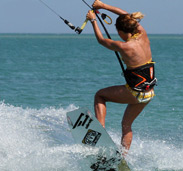 Your pop is going to spring you up off the water, and thus your front rotation needs to compliment this. In a standard front loop when the kite is utilized for height, you’re more than likely to throw your head and shoulders down and around to start rotating. This works because the kite gives you an up force.
Your pop is going to spring you up off the water, and thus your front rotation needs to compliment this. In a standard front loop when the kite is utilized for height, you’re more than likely to throw your head and shoulders down and around to start rotating. This works because the kite gives you an up force.
When popping, if you throw your head down towards your front shoulder, you’ll be neutralizing all the good work you’ve done getting up off the water by forcing your body weight down, and that would be counterproductive. Instead, you need to lift your chin and turn to look up and over the back shoulder as your rear leg extends, see picture on your left hand.
To some, this does not seem to be essentially wise, as you are straightening your back and turning it towards possible impact, whereas the original front loop was a safe roll as if you were crumpling up to break a fall. The second difference is your body can stay extended in a popped front loop, whereas in the jumped version, you are trying make yourself a bit compressed.
ALL IN THE HEAD
Your head is the key to completing this rotation. Half way around you are in prone position, because the kite will be pulling you forward, you will not be able to force your hips, legs and board around in front of you, while your legs are hanging behind and upwind of you.
To finish your spin, you’ll need to look over your shoulder at where you wish to go and then push your hands around to follow. By doing this, your upper body will be facing downwind and the rest will have to follow.
STEERING WHEEL
There is a tendency to pull on the back hand as you carve against the kite. This is more than normal, but it should be avoided. However, if you do find your kite drifting up, give it up a pull on your front hand and a push on the other hand as you come around your rotation. If this still doesn’t help, try pulling on your front hand as you take off.
ALL IN SEQUENCE
- Park the kite in 11 o’clock. Carve hard upwind for maximum pop. Put your weight low and towards the back on the board. Extend your front leg. Ride against the power of the kite whilst looking forward.
- As soon as you feel your shoulders being pulled forward over your hips explode off the water by rapidly extending your back leg.
- Your aim is to spring up and turn your head towards your right arm to initiate the rotation.
- As the kite pulls you forward continue the rotation and keep looking rounds towards your back elbow.
- You are now half way through this trick. You´re facing upwind and are fully powered so you better complete your rotation.
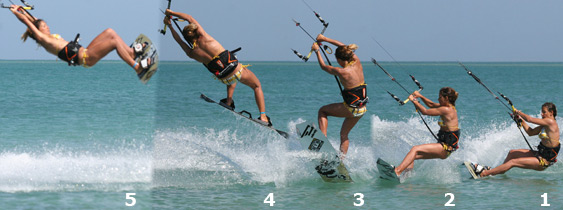
- Try to get a glimpse on where you´re going by spotting a potential landing.
- As your head comes around force your bar and hands around too.
- With your head and shoulders facing forward, the rest of your body follows and you can start dropping down your legs down under you.
- Land the tail first on preferable flat water, slightly off the wind. Soften the knees to absorb the landing and keep looking forward, not down in the water.
- Catch an eye on the kite to make sure that it´s not diving into the water, correct if necessary. Then keep heading towards the kite on a flat board.
- Time to take a hand off and hook back in.
BEST TIPS
Don’t take too much speed into this technique at first, as it’ll feel like you’re in a rush, yet alone rotate and land.
As you develop, you should try and start with the kite a tad lower and keep it still.
As you progress with more power, focus on popping up into the Raley first and then start your rotation.
If your kite is starting to misbehave and is hurling up away, try moving your back hand to the center of the bar with the chicken loop line running between your first two fingers.
A NICE VIDEO OF THIS TRICK
Toe Side Pop Out to Wrapped
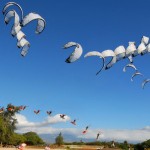
Popping from a toe side and landing in a wrapped is a great start to wrapped if you haven’t tried it before, and if you can already manage a shifty or more to wrapped, then this should be a doodle and a surefire way of adding extra style points to any move you land in toe side.
For those of you who have never tried a wrapped, it is releasing the front hand and rotating away from the bar so that you can reach around behind you and land on heel side with your arm in a self-induced arm lock. If you can go blind one way, imagine going the other way but still releasing with the same hand and turning the exact same way.
LOW AND NEAR
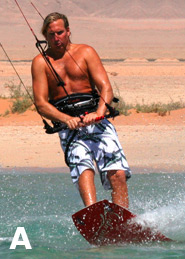 In pic A, you can see that the surfer is almost carving
In pic A, you can see that the surfer is almost carving 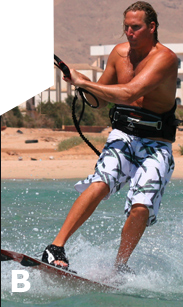 downwind away from his toe side edge. This is very sudden change of direction that does two things. First, it allows you to keep your speed for a moment even without pulling the kite, which means your board will still be planning; therefore you will be able to pop without it sticking. Second, by suddenly turning towards your kite, the lines will slacken and the bar will be light in your hands so you can keep it low and close.
downwind away from his toe side edge. This is very sudden change of direction that does two things. First, it allows you to keep your speed for a moment even without pulling the kite, which means your board will still be planning; therefore you will be able to pop without it sticking. Second, by suddenly turning towards your kite, the lines will slacken and the bar will be light in your hands so you can keep it low and close.
In pic B – Just as the surfer is about to pop, you can see that the bar is in close. With the slack in the lines the surfer can bend his arms and make sure the bar will close to him all the way around his 180 degree spin. You can also see that the kite is relatively low, say around the 45 degree mark. With the kite here it is less likely to pull the bar up and away from you. Also, ( as you’ll be releasing with your front hands) if the kite does move, it will go up, so starting with a lower tad is a good option. If you are popping off flat water, you will need to let go with your front hand as you heave up.
SPEED
As we have already mentioned, you can throw this pop whenever you come fast in your toes from another move. However, when you are trying this for the first time as a pop from toe side, your approach is pretty important because you will need speed. The simplest way to maintain speed is to unhook whilst riding heel side as you will have a better unhooked riding position. Then, you can slide the back of the board straight downwind and you are ready to pop from a very off the wind toe side. However, once you get the hang of it, you could unhook from toe side or just before you pop.
TIMING IN SEQUENCE
1 – Having approached with good speed and his kite positioned at about 10:30, the surfer has unhooked and the spun around to a very downwind toe side chasing the kite. Getting ready to pop the surfer has rocked his weight back over his trailing foot and flexed his back knee. The surfer got his bar in close to his body and is ready to spring.
2 – The surfer stamps down hard on his back foot and extends his body upwards. At the same time the surfer releases his front hand enabling him to stand over the board for a balanced spin.
3 – AS the board rises, the surfer lifts his legs and starts his rotation by turning his head and shoulders down and away from the kite.
4 – The surfer twists his wrist and turns his palm up behind his back, which helps him turn his shoulders further still. At the same time the surfer pushes his left foot through to get the board in front of him.
5 – On landing, the surfer makes sure that the bar is twisted all the way around and ready to be grabbed.
6 – The surfer reaches with this free left hand and grabs the bar.
7 – then releases his right hand.
8-9 – The surfer continues to turn his head and looks up towards the bar and gets both hands back on the bar.
10 – Sail away, hook back in and then try it from a railey to toe side.
KEYSTONES
- Speed
- Sudden chase kite
- Pop hard off back foot
- Turn head all the way
- Twist wrist and shoulders
Shifty 2 Wrapped
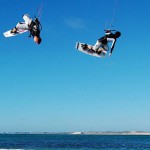
This is a cracking move, which look phenomenal, feels amazing and is actually easy to nail consistently once you have got it. So what is Wrapped? If you haven’t contemplated what landing wrapped is, try visualizing that you are about to land toeside but you continue rotating and turn the board for you to be able to rotate another 180 degree to land heelside whilst releasing your front hand. The effect is that you’ll land with your back hand twisted up in half behind you.
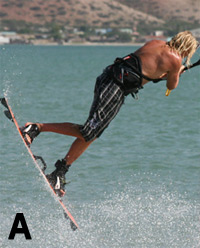 Pic A – We can see how the surfer used his back foot and the back board. The front foot is lower than his back foot and his back foot is further upwind than his front foot. In fact, the shifty has been lifted at the end of the board whilst his extended front leg has pretty much left the nose of the board.
Pic A – We can see how the surfer used his back foot and the back board. The front foot is lower than his back foot and his back foot is further upwind than his front foot. In fact, the shifty has been lifted at the end of the board whilst his extended front leg has pretty much left the nose of the board.
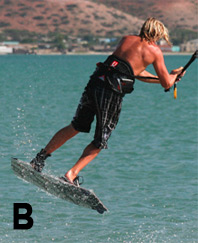 Pic B – As soon as the
Pic B – As soon as the 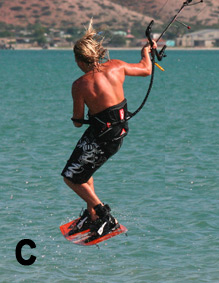 surfer stops holding his shifty position, the gravity takes over. His back foot and the weight of the back board drop down and accelerate as they go, creating some high and useful momentum. Once again the static front, which isn’t falling, acts as a pivot point so the back leg starts to swing around for toeside landing.
surfer stops holding his shifty position, the gravity takes over. His back foot and the weight of the back board drop down and accelerate as they go, creating some high and useful momentum. Once again the static front, which isn’t falling, acts as a pivot point so the back leg starts to swing around for toeside landing.
Pic C– This picture shows the result of a tasty amount of rotation which should be an easy task for you to get around the wrapped.
The only thing left to do then is to release your front hand, twist your wrist around and turn your head. Do not let go as you aim to land in a wrapped position.
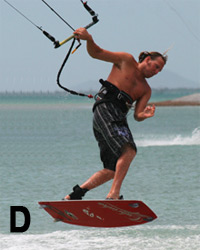 Pic D – Shows that the kite drifted up and the surfer does this move with his hand centered on the bar with the chicken loop line in between his first two fingers.
Pic D – Shows that the kite drifted up and the surfer does this move with his hand centered on the bar with the chicken loop line in between his first two fingers.
SHOWTIME SEQUENCE
1. As per usual, the surfer has come off the wind to unhook and set himself up for take-off. The surfer pushes the board out in front by extending his front leg which gets his weight over the back foot. The more off the wind the surfer goes the less carve to far up into the wind and get a raley take-off.
2. The surfer gets back onto his edge by dropping his weight to upwind and carves the board against the pull of the kite.
3. With his weight over his back foot, the surfer allows him to be pulled up and explodes off his back foot. Immediately leans his head over his back arm and keeps his front leg extended. Because the kite isn’t too high, his arms do not get pulled up over his head.
4, As the board leaves the water, the surfer keeps his front leg locked and starts to swing his back leg upwind.
5. With the board pivoting around his front leg, the surfer keeps his weight forward, holding the nose of the board down and lifts his back foot up towards his backside.
6-7. Once the surfer feels that landing is near, on the way down the surfer release his shifty and let the board swing down. At the same time pulling the bar towards his back knew as savagely hard as possible and kicks his back knee towards the bar. This gets the rotation to wrapped underway.
THE LANDING AND THE PASS
1. Having pulled the bar toward his knee and kicked his knee towards the bar, the surfer is spinning fairly and rapidly. The surfer twists his wrist as the turn is on for the preparation of the bar, which also allows him to turn his shoulders further. His head is turning to look where he is going and his right knee is still driving around.
2. Having turned, the surfer’s main aim is to land on a flattish board and hold on to the bar. To do this, the surfer rotated around and got his hips centered between his feet. This will give him a stable platform to land on and give him the balance to pass the bar. You can also see that his palm has turned all the way up. This means that the bar is ready and waiting for the other hand, and it also stops the shoulder from getting pulled.
3. With the bar twisted and waiting in place, the surfer reaches up with his other hand and grabs the bar from underneath with his free hand and palm up. The surfer also starts to stand tall.
4. Now that the surfer is upright, the surfer quickly releases the bar and cunningly gets out of the wrapped arm lock.
5-6. The surfer turns his head and looks where to go, reaches forward to get two hands back on the bar and hook back in.
KEYSTONES
1. Front leg straight
2. Back leg up and round
3. Big effort from hands to knee and knee to hands
4. Twist your wrist and shoulders
5. Land with weight slightly on toes
A video of this trick:
Unhooked Downloop
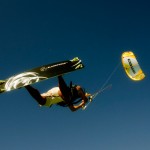
The unhooked downloop is a satisfying piece that unluckily does not get enough airtime these days. When it is at home this move is performed with a pop at the same time the kite loops in a forward direction, which unavoidably will pull you forward into a raley position. As the pull from the kite comes from your front, it is not that too aggressive, and it is another unhooked move that can be easily performed when you surf at an agitated water. Finally, this trick is the originator for a downloop S-Bend.
ALL IN THE TIMING
In pure timing terms you need to be popping early. You should be able to pop from the speed that you take into the move. This way you do not need to let the kite loop move to give power to perform the pop. The result of this is that you will be going up as the kite starts to go around, simply meant that you will get more land and height as the kite finishes its loop move. The longer you wait the lower the kite you’ll fly. This will also end up with the kite starting another rotation before you land.
UNHOOKING A HIGH KITE
Your first concern is the position of your kite. Ideally you will have your kite pretty much at 12 o’clock to start this move. It is good, but you need to unhook too. This means that your approach needs to work for you. With your kite high, the problems of slowing down and not being able to unhook are lurking in the wings. On your approach you will need to drift the kite up at the same time edging hard and then at the last minute bear away loads to slacken the lines off and then go to unhook. Your body position here for unhooking is crucial, so make sure that you push your hips up and shoulders back, otherwise the chicken loop will not slip out easily.
REDIRECTION
Next you need to get your hands sorted. You need to release your back hand and reach forward to grab the bar just underneath your front hand in a fish pole grip during the redirection phase. There is no relevance to whether you are right or left handed. The important thing only is that your front hand steadily stays up against the center line and the released back hand grabs in close to it as possible. If you have just lathered up with some factor 50, this could prove a tad tricky. The slick movement to one side of the bar will get the kite turning sharpish into a downloop.
THE POP
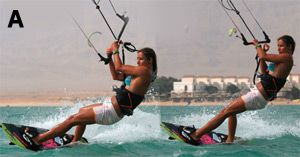 You should be well aware by now of the need for a decent edge to pop-off. If you enter with the correct body position, it will be easy enough to get onto your edge quickly. Your shoulders should be in a back position and your hips forward. Even more importantly is that you need to extend your front leg, so your hips are over your back foot and aim upwind while your hips and shoulders twist. This will allow you to drop your bum low to the water and get into a solid craving position in a quick time. Notice how the surfer has already started to drop into carving after the back hand is released. By doing this, the surfer will have a perfect phase to pop off from the edge before the kite gets too far into its downloop. The surfer will explode up off his back leg by suddenly straightening it, kicking it down onto the heel of his back foot to pop perfectly.
You should be well aware by now of the need for a decent edge to pop-off. If you enter with the correct body position, it will be easy enough to get onto your edge quickly. Your shoulders should be in a back position and your hips forward. Even more importantly is that you need to extend your front leg, so your hips are over your back foot and aim upwind while your hips and shoulders twist. This will allow you to drop your bum low to the water and get into a solid craving position in a quick time. Notice how the surfer has already started to drop into carving after the back hand is released. By doing this, the surfer will have a perfect phase to pop off from the edge before the kite gets too far into its downloop. The surfer will explode up off his back leg by suddenly straightening it, kicking it down onto the heel of his back foot to pop perfectly.
ENTERTAINING AIR
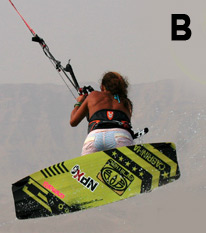 Once you pop up into the air your objective is to follow the pull of the kite. By doing this you will keep your balance and will give you an enough inclination for the landing. The simplest way to go with the kite’s pulling force is to watch it. You can see that the surfer is being pulled through the air by his downlooping kite. Head is in line with the bar, which is pointing at the kite. In a powered downloop, your feet might flick up slightly behind you. As long as you look at the kite, it will not twist you. Also by looking up at the kite, the surfer’s head is lifted. This will make it easier for his feet and board to drop underneath. If you feel the need to take off a hand off for balance, then it must be your back hand.
Once you pop up into the air your objective is to follow the pull of the kite. By doing this you will keep your balance and will give you an enough inclination for the landing. The simplest way to go with the kite’s pulling force is to watch it. You can see that the surfer is being pulled through the air by his downlooping kite. Head is in line with the bar, which is pointing at the kite. In a powered downloop, your feet might flick up slightly behind you. As long as you look at the kite, it will not twist you. Also by looking up at the kite, the surfer’s head is lifted. This will make it easier for his feet and board to drop underneath. If you feel the need to take off a hand off for balance, then it must be your back hand.
TOUCH DOWN
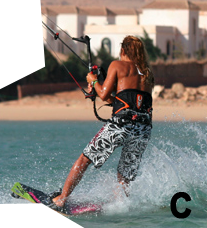 As we mentioned keeping your head up, allow your body to fall into a normal vertical position. If you can keep your arms, or front arm bent, the pull will bring your leading hip forward and set you up for a pleasant downwind landing. The surfer is upright over his board. This gives him the option of going either way depending on where the kite is going.
As we mentioned keeping your head up, allow your body to fall into a normal vertical position. If you can keep your arms, or front arm bent, the pull will bring your leading hip forward and set you up for a pleasant downwind landing. The surfer is upright over his board. This gives him the option of going either way depending on where the kite is going.
When you first land a downloop, follow the kite downwind and watch it loop again. As you see it turn through the center of its rotation and is starting to come up, grab the back of the bar with the hand you swapped over. If you do not get the right timing, just grab the chicken loop and let go of the bar. At least the kite will flutter up and you can sort yourself out.
SEQUENCE FOR THE POP PREPARATION
Pic 1 – The surfer approaches with the kite around 11 o’clock and starts to drift the kite up with a sudden pull-away to allow the body to be pulled up over the board, flattening it and pushing the front foot towards the kite and leaning with the back foot with weight over.
Pic 2 – The surfer forces his hips forward and up at the same time pulling down with both hands.
Pic 3 – As the surfer pushes the bar away and the chicken loop out, the surfer starts to drop his bum and shoulders away from the kite and looks where to go and not at the kite.
Pic 4 – The surfer swaps hands and starts to get back on the edge by driving his feet away.
Pic 5 & 6 – The surfer twists his hips and shoulders to face more upwind, forcing the board to carve hard onto its edge. The kite is starting to steer down and will pull soon
Pic 7 – The surfer pops up hard off his edge extending his back leg.
SEQUENCE AFTER THE POP
Pic 1 – As the surfer pops up the kite, pulling forward is the main goal with offering no resistance at all.
Pic 2 & 3 – The surfer looks towards the kite to keep the balance all the way.
Pic 4 – As the kite starts to rise again, it stops pulling and the surfer starts to drop down. Keeping the bar pulled in with bent elbows, this turns the surfer naturally to follow the kite.
Pic 5 – With the head of the surfer up, the feet and the board drops under and releases the back hand for some added balance.
Pic 6 – The surfer lands over the board, waits for the kite to rise, and then gets the other hand back on the bar.
KEY MARKS
- Kite at 12 o’clock
- Unhook with shoulders back and hips forward
- Change hands
- Carve and pop early
- Follow kite once in air
The video of this trick:
Kite Loop to Wrapped
The Kite Loop to Wrapped is a desirable technique in its own right which demonstrates superior control and landing satisfaction. Though it is also a vital step to kite loop 3, surely, there are benefits in learning the wrapped version first.
Firstly, you have more time to focus on the kite loop as the timing for the spin is a last minute thing. Rather than looking forward for the moment to spin, better to wait for it. Secondly, you don’t need much height so you can get away with less power which makes a more pleasant learning experience. Thirdly, as an outcome of both of the above, to succeed is all about technique and has nothing to do with aggressive force. Once you’ve got it, you can move onto the full 3 version a whole lot easier.
If you are coming into this as a relatively new recruit to wrapped, it is recommended to practice on your shifty to wrapped first as this is the primary building block of a quick spin to wrapped.
HIGHLIGHTS OF THE TRICK
THE TAKE OFF
Whether you’ll be going for a kite loop with or without wrapped or a pass, what your kite does will affect your chances of success, and what your kite does is remarkably influenced by your approach and take off as you’ll be learning this technique with a fish pole grip, you have no way of controlling the speed at which your kite loops with your hands instead the rest of your body.
Chances are, when you first attempted an unhooked kite loop, you changed your hands and the kite looped before you had time to think, dragging you off downwind vigorously and most likely splash you into the water. The simple reason for this is that you need to pop to get off the water and let the kite do the rest when you’re up. If you just edge hard, you put more tension on the lines and the kite moves fast.
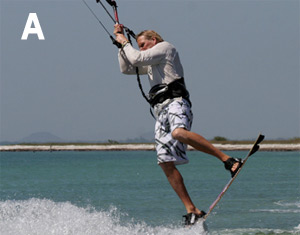 In Pic A, the surfer basically just eased off downwind with the kite at 12:00, unhooked and reached under and back with front hand to grab the back of the bar and popped up off the back leg right away. You can see how the surfer’s whole body from feet to shoulders is aimed upwards and not back against the pull of the kite. Because the kite is not breaking the surfer up off the water, maintaining the arms bent is easy and therefore keep the bar close.
In Pic A, the surfer basically just eased off downwind with the kite at 12:00, unhooked and reached under and back with front hand to grab the back of the bar and popped up off the back leg right away. You can see how the surfer’s whole body from feet to shoulders is aimed upwards and not back against the pull of the kite. Because the kite is not breaking the surfer up off the water, maintaining the arms bent is easy and therefore keep the bar close.
Because the surfer is no longer resisting against the kite, it will turn slower. And because the surfer has popped up, the kite will hurl up providing more height effortlessly. The longer you carve on the water, the more vigorous the break from the kite, the further back the kite loop and the lower he resultant jump.
This will only be possible if you unhook with your front leg pushed out in front of you, your hips dropped right back over the rear foot and your shoulders back. From this state, you can swiftly carve and pop.
THE SHIFTY
We use the term shifty freely as we don’t want to get into any discussions about style. Let’s agree that in this case what we mean is the extension of the rear leg behind us. As with the shifty to wrapped by kicking your rear leg behind while in the air, you then can bring the knee up and through which will assist you to spin faster and further. For sure there are many surfers, who spin without extending their leg first, but we’re in the market of making this easier for all involved, and this absolutely helps.
The other benefit to this position is that it allows you to use the “flick” of the kite. This being the point at which the kite tries to knock you off balance, usually by swinging your legs forward as the kite turns back. With the back leg extended, you can then pull the knee up towards you to regain your stability and hyphen up your rotation speed.
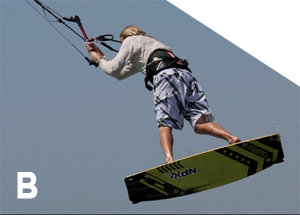 In Pic B, you can see that the surfer kicked his rear leg and foot up behind as the kite pulls. As with the shifty to wrapped, the surfer didn’t let those arms extend, instead keeps the bar close. Looking at the image, you can see that there is almost a straight line running from his hands through his back knee to his rear foot. If you were watching the kite, it would just be turning through the bottom of its arc and is beginning to rise.
In Pic B, you can see that the surfer kicked his rear leg and foot up behind as the kite pulls. As with the shifty to wrapped, the surfer didn’t let those arms extend, instead keeps the bar close. Looking at the image, you can see that there is almost a straight line running from his hands through his back knee to his rear foot. If you were watching the kite, it would just be turning through the bottom of its arc and is beginning to rise.
THE ROTATION
More lower body work out here. It is all about getting your hips, legs and board to turn. Your upper body will follow your head but if you don’t get the lower half moving, it’s good as nothing.
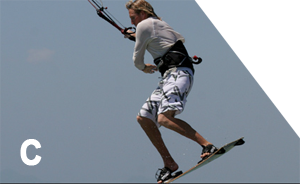 In Pic C, the surfer is dropping and feels that there is much less pull in the bar. This is the signal to start spinning and this is the advantage of learning to wrapped. In this image, there are two important things.
In Pic C, the surfer is dropping and feels that there is much less pull in the bar. This is the signal to start spinning and this is the advantage of learning to wrapped. In this image, there are two important things.
Firstly, if you look at the surfer’s right foot, you can see how it is lifted off the footpad. This indicates just how vigorously the surfer has pulled his knee, foot and the rear of the board forward towards his hands. Because of the shifty, the surfer was able to do this.
Secondly, look at the position of the left hand. It is almost wrapped around. This is because the surfer has not pulled the bar into his back hip, but rather has pulled the bar past the hip and down as if pulling a paddle along the side of the raft. So the hands have been drawn down towards where the rear foot was and the knee had been brought forward to get the board under the bar and the bar under the shoulders.
Once you get the board under, you can then rotate with your head to get your upper body around on a vertical axis. If you rotated before the knee came through, the board would be left behind, and you would rotate off axis and be dragged off balance.
FINAL STEPS TO REMEMBER
Before you go for any wrapped landings, give yourself more allowance by knocking out a handful of unhooked kite loops first. Aim about taking off early, extending the rear leg and feeling the tension disappears as you drop. This way, you’ll get a sense for when you need to spin and also provides you the right amount of power and height. If you feel like you are overdoing it, it may not be the right day to try.
Consider trimming your kite too. You want your kite to be looping circular, not to be turning around its wing tips. On the majority of kites, if you don’t trim them down enough to unhook, they will flare/reverse/halt. This will result in a tight wing tip axis and won’t give you the feeling that you need or much of a chance of succeeding. Defined and controlled is better than wild and unpredictable as you can build on it.
SEQUENCE SUMMARY
1. Have a good look around to make sure you have enough space. The surfer moves his kite up to 12 o’clock, pushing the board off the wind with a straight front leg unhooks with his shoulders still back.
2 & 3. After unhooking, you need to reach under and back with front hand to fish pole the bar, drops weight back and upwind.
4. Hard carve upwind and ready to pop…
5. ..and explodes up off the rear leg before the kite starts to pull. When you pop, you need to keep your arms bent and the bar in close.
6. As the kite loops back and down, it’ll pull you towards it. Kick the rear leg out behind and hold on tight. To help with balance, you can look over the bar towards the kite.
7. As the kite starts to rise, it stops pulling and you’ll start to drop as well. This is the perfect time to spin just as you feel the power. Pull arms in and down past the back hips hard and pull the rear leg in even harder.
8. Keep pulling on the bar, try to pull it past the hip and release only the front hand as your lower body and knee will come through.
9. With the lower body turning, start to turn your head and shoulders so that you can continue to spin far enough to land with the board pointing downwind.
USUAL PROBLEMS
- If you find that the kite drags you hard downwind and not skyward. For sure you are edging too long before popping up. Don’t wait for the kite to pull, just change your hands and pop.
- If you still couldn’t get enough height. Make sure that you start with the kite positioned as near to 12 o’clock as you could. You should hurl the kite up before you unhook.
- If you bounce off the back of the board when you land. You are not getting your feet forward enough as you rotate. Always bring your knees all the way through and up.
- If you can’t reach for the bar. Make sure you pull the bar down towards you and keep your arms bent all through the loop. Finally, you’ll need to pass out the wrapped nice and quick; otherwise the kite will just continue to loop around.
KEY MARKS
- Kite at 12 0’ clock
- Pop up early
- Keep arms bent
- Kick rear leg back
- Bring hands and back knee together when you feel the power coming.
You should do like this:
Front Loop from Toe side
Front Loop from Toe side
The front loop from toe side is an extra bit of fun for anyone who wants themselves as proficient toe combo specialists. It is a very attainable move and can lead into a surplus of combos and tricks, both hooked and unhooked, so this is a must have for any promising crowd pleasers around you. As you start from your toes, you’ll find that the kite does a lot of work for you when it comes to spinning. As long as you get the take-off and you keep controlling the kite’s atmosphere, it will be a well aligned move.
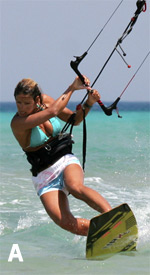 Pic A – The surfer is edging against the kite. Not wanting to draw too much attention to it, but this is another classic kite face trick. If you thought edging upwind requires some effort, now you will edge upwind and try to keep your weight low against the lift of the kite, you will need to use all your steel on it.
Pic A – The surfer is edging against the kite. Not wanting to draw too much attention to it, but this is another classic kite face trick. If you thought edging upwind requires some effort, now you will edge upwind and try to keep your weight low against the lift of the kite, you will need to use all your steel on it.
For starters, trim your bar down towards you. With the bar nearer your body, you will be able to edge well with both hands on the bar, thus being able to send the kite and keep the control on it. Even though the surfer’s bar is angled back to send the kite, the front arm is still bent slightly, so the kite doesn’t pull the surfer around. You can see how the surfer has his neck twisted and face really looking over his shoulder and down. This allows the surfer to commit against the kite and keep the body weight low and forward, whilst still keeping both hands on the bar. This way the surfer is able to hold the edge for that a little bit longer. Just like with a heel side jump move. If the surfer has a cheeky peek at the kite, it will come off the edge.
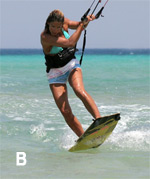 Pic B – Demonstrated the take-off perfectly. The surfer has popped up off the water after the feeling of the rising kite has been felt. Even though you use the kite for this trick, you need to “go early” because you’ll not be able to resist the same way that you do on your heels. Even though the surfer is extending up, keep the head down and twisted around plus continue to commit the weight upwind against the pull of the kite. It is tempting to drift the kite up slowly, but if you are fairly aggressive, you have more chance of holding your edge until the right time. This is your only chance to give yourself enough height to complete the move.
Pic B – Demonstrated the take-off perfectly. The surfer has popped up off the water after the feeling of the rising kite has been felt. Even though you use the kite for this trick, you need to “go early” because you’ll not be able to resist the same way that you do on your heels. Even though the surfer is extending up, keep the head down and twisted around plus continue to commit the weight upwind against the pull of the kite. It is tempting to drift the kite up slowly, but if you are fairly aggressive, you have more chance of holding your edge until the right time. This is your only chance to give yourself enough height to complete the move.
Also, as the surfer starts to take-off, the bar levels have been off already. This is due to popping up early. As the surfer essentially loses the edge as the pop goes, the kite will fly further back as the surfer pendulum underneath it. Once again this is only possible because the surfer has the bar trimmed in near.
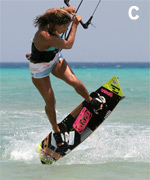 Pic C – The final part of the surfer’s take-off is the initiation of his forward rotation. Just as with a heel side front loop, much of the momentum comes from the back leg kicking off the water, and as the surfer popped off, his back leg will help in that phase. If you look at the surfer’s head, it is no longer looking upwind over his shoulder. By turning his head to look forward and downwind, his body will automatically start to uncoil, and this is a further help by the kite pulling in the harness hook.
Pic C – The final part of the surfer’s take-off is the initiation of his forward rotation. Just as with a heel side front loop, much of the momentum comes from the back leg kicking off the water, and as the surfer popped off, his back leg will help in that phase. If you look at the surfer’s head, it is no longer looking upwind over his shoulder. By turning his head to look forward and downwind, his body will automatically start to uncoil, and this is a further help by the kite pulling in the harness hook.
From here onwards it is all about keeping the bar in and keeping the kite forward while getting your body tucked up and small, so that you can look over your back shoulder and complete the rotation.
Sequences
1-2. With his kite at 1 o’clock and riding with good speed on his toe, the surfer edges hard and sends his kite back for a jump whilst trying to look upwind.
3. As the kite starts to lift up, the surfer explodes up off his back leg whilst committing his weight upwind and of the board.
4. As the surfer kicks off, turns his head and looks downwind under the bar. At this point the surfer is already redirecting the kite forward with his front hand.
5. This impulse coupled with the pulling of the kite, the harness throws the surfer into a front rotation. You can see how the surfer is pulling hard on his front hand.
6. This looks familiar. The surfer is now facing upwind and it looks exactly like a normal front loop. The surfer has the bar pulled in to keep the tension on the lines, the surfer is looking over his back (left) shoulder to continue rotating combing with his knees pulled up to increase the speed of the rotation.
7-8. The surfer keeps looking over his shoulder in an effort to see the water and where to land.
9. As the surfer completes his rotation. The surfer dives the kite hard with his front hand and focuses on his landing.
10. The diving kite pulls the surfer off downwind and stops his rotation. Now the surfer can drop his feet and is ready for the landing stage.
11. The surfer lands tail first with his board pointing downwind for a clean landing. From here the surfer can gather his thoughts before carving back onto his edge and not spinning his bar.
Keystones
1. Trim your kite to get the bar close
2. Edge hard by turning your head upwind
3. Send the kite (do not drift it.)
4. Pop early and turn your head the opposite way
5. Redirect with meaning
And the video:
Popped Front Loop
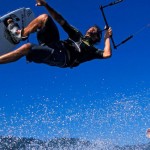
It’s always good when you have the chance to learn something that looks exquisite; the hooked in Popped Front Loop is such a cherub. Even when it is too windy to show off all the technical tricks in your armory, this adds up with a cheeky Indy Grab that will keep most of the pop fanatics happy. It is a great way to get your head around an unhooked popped front and it is a welcome alternative to a sent jump front. It will work on the flat off a wave and because you can control the power in the kite, even the chop won’t stop you.
The essence of any pop trick is that all your upward force comes from you alone, with no help from the kite. However the position of your kite will affect how much height you get. The nearer it is to 12 o’ clock the more lift you will have. So it stands to a reason that if you are learning this move, you should have the kite around 11 o’clock. This way the kite will be just low enough that you can edge against, but it will also be high enough to give you some bonus lift and assist with getting your board back under you.
IMPORTANT STAGES
The Approach
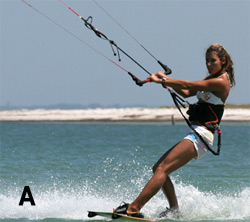 As you won’t be using the kite for the lift, you will need some quickness and speed so you can pop hard. Assuming that you popped, you will already know that generating your speed can be increased by heading slightly off the wind with the power of your kite. Just try and change your direction smoothly by steering the board in front rather than standing up on it.
As you won’t be using the kite for the lift, you will need some quickness and speed so you can pop hard. Assuming that you popped, you will already know that generating your speed can be increased by heading slightly off the wind with the power of your kite. Just try and change your direction smoothly by steering the board in front rather than standing up on it.
Pic A – Shows that the surfer is in a perfect pre-pop position. The kite is on 11 o’clock direction and has steered the surfer’s board off the wind by the feet’s extension. To maintain a good stance, you need to push your front leg out and move your hips back behind your back foot. Your shoulders should be still behind your hips and the board is still in between you and the kite. Keep your hands on the center of the bar to prevent any unwanted kite movement. Here you can acquire speed that will give you an attempt to carve back onto your edge.
The Carve
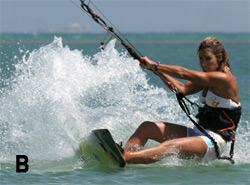 This isn’t the moment to consider on as in reality it only lasts a split second. However your body position here is the important thing because it defines the amount of pop that you will get. Visualizing it first and foremost can be of benefit.
This isn’t the moment to consider on as in reality it only lasts a split second. However your body position here is the important thing because it defines the amount of pop that you will get. Visualizing it first and foremost can be of benefit.
Pic B – Best Place to start is the surfer’s kite face. To get a decent pop and enough rotation, you need a bit of an effort and aggression to go up. Next see how close the surfer has his derriere to the sea. This is only possible because of the position taken into the pop. With the surfer’s weight back and upwind, it is easy enough to get back on the edge by turning suddenly on upwind. Using your shoulders to twist your body around your hips for the board turn can give you a quick flexibility for the move. See that the back leg of the surfer is flexed and ready to extend, and the front leg extension keeps the surfer’s board on edge. As soon as you get into the position, you must be ready to pop up or else you will lose speed. Final point here is not to pull on the back hand.
The Take Off
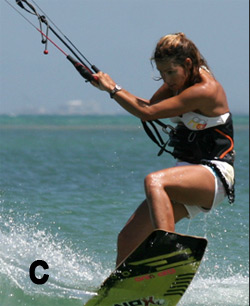 As you know from a front loop, the take-off is everything as it initiates the rotation. It also needs to give you pop so the trick is to fire yourself into the rotation without flattening the board off.
As you know from a front loop, the take-off is everything as it initiates the rotation. It also needs to give you pop so the trick is to fire yourself into the rotation without flattening the board off.
Pic C – shows that the surfer explodes for the take-off. You can see how the back leg extends against the resistance of the edge of the board, thus pushing the body up. However unlike a sent front loop, it doesn’t throw across the board towards the sea on the other side, as this would flatten the board. Instead the surfer throws his head towards the nose of the board allowing a bend sideways at the waist. This stage is enough to start the rotation. Faith is the key.
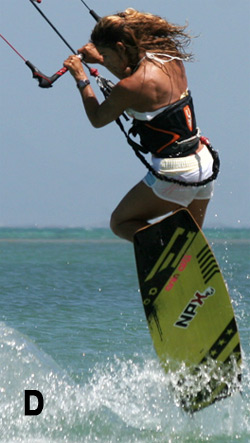 Pic D – Clearly demonstrates the commitment to the pop. As the surfer goes up, bar-in is the one you should keep in mind because if you do so, rotation can be easy in middle lines. See the surfer’s front hand as his steering connection slows down the kite to make sure it doesn’t drift up. The surfer is now in a textbook position to throw the rotation. With your back leg extended and front leg bent combined with your weight down, your next step is to forward now to speed up your rotation and turn your head to look back over your trailing shoulder and bend your back leg.
Pic D – Clearly demonstrates the commitment to the pop. As the surfer goes up, bar-in is the one you should keep in mind because if you do so, rotation can be easy in middle lines. See the surfer’s front hand as his steering connection slows down the kite to make sure it doesn’t drift up. The surfer is now in a textbook position to throw the rotation. With your back leg extended and front leg bent combined with your weight down, your next step is to forward now to speed up your rotation and turn your head to look back over your trailing shoulder and bend your back leg.
Pointers to Consider
It is highly recommended practicing kiting across the wind with a speed before bearing away and then turning up again to concentrate on your body position. Once you have done this a few times, just add the pop off the back leg and you will find that popping hard with your front shoulder is actually easy. If you lose balance, most likely you are not bearing away enough before carving hard. The more downwind you start the less far you have to rotate.
The Trick in Sequence
1-2. Notice the surfer keeps the bar in close, keeps the kite steered forward and throws his head and shoulders down towards the nose of the board. Now that the board is clearly off the water, the surfer needs to rotate faster.
3. The surfer quickly turns the head to look back over his rear shoulder.
4-5. As long as the surfer keeps the bar the kite steered forward while he keeps looking over the shoulder, the rotating will continue to go.
6. Once the surfer can see the water, the concentration will be on where to land.
7-8. As the surfer’s leg comes around, the extension of the legs should be ready for landing. Aiming to land the tail first, pointing downwind on a flat board and not on the edge the surfer carries a fair amount of speed. As long as the tail lands first, the board can pivot further around and downwind.
9. The surfer lands, absorbs the impact and keeps head up looking where to go with balance in hand. The surfer has the bar in and the kite steered forward always.
Key Marks
1. Speed, off the wind
2. Weight back over tail off board
3. Carve hard, pop up and forward
4. Steer the kite down
5. Flick! Good job!
Here´s what it will look like!
Hooked in Front to Blind
Hooked in Front to Blind
Once again the combination of moves from a blind looks truly amazing. Apparently, several hooked-in moves are outshined by their unhooked counterpart, which is great shame as they still showcase a lot of techniques and can still look so neat. It is indeed a medley of Hooked in a flare.
By Popping High, you should patiently wait to travel forward before performing the “Throw” and “Blind” at the decisive moment. We will begin with the front to blind as for many reasons; it will be the simplest step for surfers to get your head around because it has definite flow in the move. You will need a fine popped front look and solid blind to get this one nailed.
To build up to this technique, it is advised that you practice a bunch of high pops to blind. This will surely help your blind timing and your patience. The focus behind this is that when you do pop to blind, they consciously keep you at a low posture so that the landing will be well positioned. This will not be the case following a front loop. By popping high, you will have to stay still to travel forward before you “throw” and blind at the decisive moment just before your board reaches the water surface. Also it will show you to break your blind rotation from your pop which implies that you can add up into your popped front roll.
Aspects of the Trick
Pic A.
At start, you have to bear away, heading off the wind for any pop technique. Park your kite at 11 o’clock and push your front foot away from you to facilitate the kite to fall back in the window for a bit and to allow your body a decent position to pop. With front leg stretched, hips over rear foot, shoulders back and upwind and head straight forward plus hands at the center of the bar, get ready to execute a clean trick.
Pic B
Popping into the front loop properly will make landing effortless. Carve harder upwind and keep the bar in to put tension on the lines, resulting the kite to pull you through the move, and as you launch, you purposely pull your front hand a little to stall the kite going up. It is important that the kite drags you through the move. Any kitesurfer is aware of that position to have something to pull against when about to throw to blind. If you hang under a high kite with loose back lines you may be able to land blind but will not ride away blind, indeed makes a lot of difference.
Pic C
Lead the spin with your head. As your head turns around, you can estimate where you are about to land. If you think it is much of a height, pull your front hand to fix this. Also, consider that the timing of when to throw the blind depends on your elevation. Maintaining your knees up watching where you are going can actually submit in a virtual slow-mo until you decide to throw the blind.
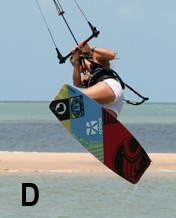 Pic D
Pic D
Focus on this segment because this is the only most important part of performing a front blind. A front to blind is not one and a half front loops, it should break the spin from your front loop around to blind. There are two parts of movements: – you appear around the front and concentrate on where you’ll land, then turn your lower body around to blind as you keep on doing it with your high loop blind.
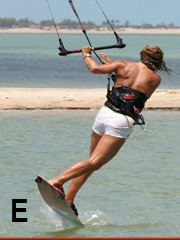 Pic E
Pic E
Granted that you have already performed a blind, now pull your right leg behind you and shift your left leg beneath which will result to landing new tail first. This will allow the board to turn all the way for a smooth landing and likewise preventing you in burying the new nose in. After a blind, you should release your rear hand for two reasons. First, it helps you turn the full total to blind. Secondly, it releases the tension in the rear lines. The kite does not drag you so you should gain stability before reaching for the bar again. You could be pulled out of the blind if you landed with both hands on the bar.
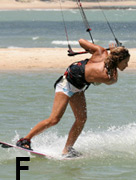 Pic F
Pic F
When you have smoothly landed and assessed your weight onto your new rear foot, reach for the bar with your rear hand. This way, you maintain your speed and can prepare you for a move from blind.
Best Tips
Discovering anything to blind is a whole lot easier if the water surface is flat, as your board maintains its speed and you can manageably run on an edge.
For the first attempt, try not to get too much elevation, if you have the kite positioned at 11 or 1 o’clock, you can pop hard but with less speed which will provide you enough time and move more accurately.
Sequence in Summary
1. With your kite parked at 11 o’clock, pop up hard with your front hand connected to hold the kite from going up.
2. As you start to spin, secure the bar in and maintains the front hand connected to hold the kite from going up.
3. To make the rotation nice and smooth, raise up your knees.
4. While the bar is still pulled in, look over your back shoulder so that you can locate your possible landing spot as early as possible and can continue the rotation.
5. Considering that you still have time to have a bit of elevation, bar in and keep the knees up.
6. Coming down, you can performs the throw to blind and shifts the board through and underneath by pulling your front knee forward.
7. As your front leg comes through, whip your back leg around and still pull the bar in with arms bent to keep you well secure to the bar.
8. As you touch down let go off your rear hand to stabilize yourself towards a landing. With the bar pulling away, the kite will automatically drag you over.
9. As the board hits and you feel like moving wobbly, reach back up to the bar to control the kite.
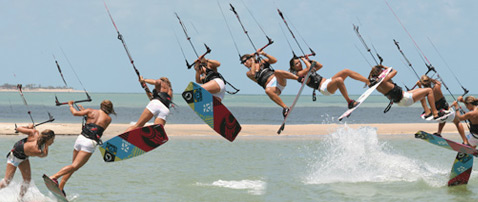
Drawbacks of the Trick
We’ve tackled it earlier but attempting to spin to blind just won’t work. You need to get the front loop organized and then whip yourself around. If you feel that you are over doing the spin, try slowing front loop down and then expedite your throw to blind. Doing the opposite is no good.
If you are landing with just minimum speed, chances are, you came into the move too slowly and with the kite way high. Try to hit the gas a bit more and don’t let the kite hurl up more. Focus on maintaining the bar in, this way, you will gain more control of the kite and will get dragged with it providing you the perfect drive upon landing.
If you fall backwards upon landing, you are releasing your hand too early which allows the kite to hurl away from you and also allows your legs and board to drop. Maintaining both hands secured helps keep the knees up and thus providing you stability.
In reality the trick looks like this:
Hooked in Back to Blind
Hooked in Back to Blind
Just like the hooked in front to blind, a nice solid pop to blind is expected of. It is recommended that you keep doing the pop even higher, wait longer before throwing the blind so you can really divide this movement from whatever still you want to execute.
The other thing you should concentrate is your trusty back loop. It will be worth your while doing slow controlled popped back loops to an uncontrolled blind. An over rotating spin will be much harder though. This signifies that your focus should be on your take-off, putting more power into popping as opposed to throwing your head around by spinning quickly.
Pic A – The surfer has just taken off, and the first thing to note is the position of the head. You should be looking at your arms and not over your shoulders. If you are ready to try this kind of move, you should be positive enough to perform a back loop around without even having to look for the landing. By looking straight ahead you will spin much slower than usual and it will be easier to stop the spin, plus you can turn other ways.
Pic B – Here, the surfer has almost finished the back loop and the board is almost 360 degrees around from the take-off downwind path. The aim here is to stop the rotation in preparation for the throw to blind. Also by pulling on the bar, you can keep powering the kite to drift downwind, which in turn will make landing a whole lot easier. You can see here that the surfer is still looking at its arms and is now ready to throw a blind.
Pic C – You can see here that the surfer keeps the bar in tight using the front hand. This stops the kite and leaves the bar behind to continue the pulling tension in the lines. To turn around, you need to let go your back hand and throw it around your back to have the rotation movement. Also, turn your head quickly to look back while pushing your front foot downwind and keep your rear foot tucked up underneath. This way the nose of the board will touch down first and goes for a clean reception. If you keep the front foot up, you will land flat on the board leading to a sudden stop and you’ll go down into the water.
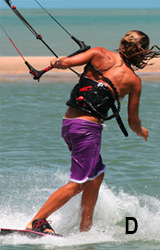 Pic D – Touching down. You can see that the surfer landed old nose first, which allows the board to pivot more downwind. Just keep your drive and look back with your weight over the old front foot. Even if you want to continue riding blind, you need to patch things up first before thinking of grabbing the bar for some movements.
Pic D – Touching down. You can see that the surfer landed old nose first, which allows the board to pivot more downwind. Just keep your drive and look back with your weight over the old front foot. Even if you want to continue riding blind, you need to patch things up first before thinking of grabbing the bar for some movements.
Sequences in Summary
1. The surfer has the kite just below 11 o’clock and has come in with enough speed to give momentum for the landing by taking off with the wind before carving up.
2. The surfer pops up off the water before turning far into the wind while keeping the head looking straight towards the arms.
3. As the surfer explodes up into a slow back loop, the surfer looks upwind and trusts the take-off to give enough rotation for the back loop.
4. As the rotation goes, the surfer pulls down with both hands towards the chest and brings the knees up and thus brings the board up towards the bar.
5. The surfer is nearly completing the back loop, pulling the hand and knees together.
6. With the board now coming forward and towards the kite, the surfer releases back hand and prepares to turn blind.
7. The surfer keeps back foot tucked up and turns head and shoulders powerfully against the back loop while keeping the bar pulled in and near.
8. The surfer lands on the old nose of the board, so it can turn to land flat and not on an edge. The surfer has all weight, knees, hips, shoulders and head committed over the old front foot.
Usual Problems
The only problem here is that every landing can be stopped if you do not have the drive going on. This technique needs sufficient speed when you take-off. Also, check your kite’s height so it doesn’t hurl up during the back loop because you will need it through the technique. Try giving a little tweak on your front hand just before releasing the back hand.
Important Keys
1. Speed off the wind
2. Pop early
3. Look through your arms
4. Tuck hard
5. Keep rear leg up
And here is what it should look like in reality:
Front Loop to Toe side
Front Loop to Toe side
We are starting this subject matter with the front loop to toe side as in fact a simple step to achieve. It isn’t something you see very often and this could help you stand out now that those pesky unhookers can’t keep hold of their bars. Doing a front loop can be measured for a high or a low loop, and once it is in the bag, you can accomplish variety of combos.
As you might have guessed, the foundation is front loop with the usage of kite, so if you are not satisfied with these, combine them first before moving on. However, many surfers find landing on one side is a difficult task. Well, this move could be the answer to your front loop prayers.
Proving a point
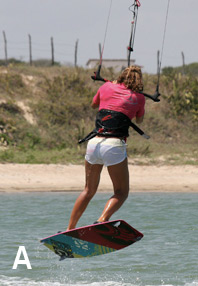 Pic A. The surfer performs a front loop to toe side riding from left to right. This means that the surfer will be kicking off the left leg for take-off but will be landing on the right leg. You can see that the surfer is in the after take-off moment, it is precisely the same movement of kite and body as for a standard front loop. Having approached with good speed provides a good edge for sending the kite back. As usual, the surfer takes-off and initiates the front loop by throwing the head and shoulder down and around kicking the back foot.
Pic A. The surfer performs a front loop to toe side riding from left to right. This means that the surfer will be kicking off the left leg for take-off but will be landing on the right leg. You can see that the surfer is in the after take-off moment, it is precisely the same movement of kite and body as for a standard front loop. Having approached with good speed provides a good edge for sending the kite back. As usual, the surfer takes-off and initiates the front loop by throwing the head and shoulder down and around kicking the back foot.
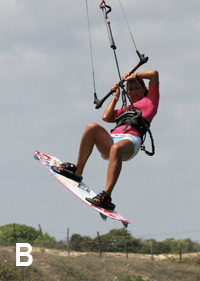 Pic B. Here it shows that the surfer is about half way through her front rotation. To land toe side you will need to land on the right foot. To accomplish this, you must push the left foot out in front of you. The simplest way to get this move is to keep the original back leg straight as you rotate. You need to bend your front leg to rotate forward and go with the flow. You can see here that the surfer’s left leg is straight and hanging down for landing purposes. All these said moves need a rotation all the way around with the head.
Pic B. Here it shows that the surfer is about half way through her front rotation. To land toe side you will need to land on the right foot. To accomplish this, you must push the left foot out in front of you. The simplest way to get this move is to keep the original back leg straight as you rotate. You need to bend your front leg to rotate forward and go with the flow. You can see here that the surfer’s left leg is straight and hanging down for landing purposes. All these said moves need a rotation all the way around with the head.
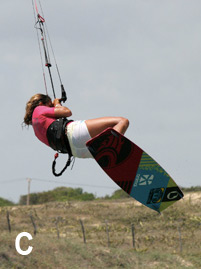 Pic C. The surfer rotates further in order to get into a perfect landing position. But before you land, you need to do a couple of task. Firstly, you need the help of the kite for a pull down to land successfully, so you must keep the bar in and the kite moving forward above by diving with front hand. If you let the bar out, the kite will get left behind and you will drop under it. You also need to prepare for a toe side landing.
Pic C. The surfer rotates further in order to get into a perfect landing position. But before you land, you need to do a couple of task. Firstly, you need the help of the kite for a pull down to land successfully, so you must keep the bar in and the kite moving forward above by diving with front hand. If you let the bar out, the kite will get left behind and you will drop under it. You also need to prepare for a toe side landing.
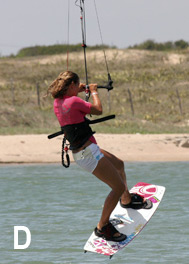 Pic D. As the kite comes over the surfer, the pressure will give a downward force against the water so the board will drop beneath and will be ready for a landing. The trick here is for the surfer to get a bit of weight forwards onto the front of the board to prevent sinking the tail and completely stop.
Pic D. As the kite comes over the surfer, the pressure will give a downward force against the water so the board will drop beneath and will be ready for a landing. The trick here is for the surfer to get a bit of weight forwards onto the front of the board to prevent sinking the tail and completely stop.
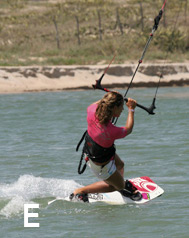 Pic E. Just after touching down, you can see the surfer’s kite is pulling because of the hard dive, which is essential in landing. This means that the surfer landed on relatively flat board thus, maintaining the speed. Now the surfer is able to carve the board onto a true toe side path by dropping weight to windward.
Pic E. Just after touching down, you can see the surfer’s kite is pulling because of the hard dive, which is essential in landing. This means that the surfer landed on relatively flat board thus, maintaining the speed. Now the surfer is able to carve the board onto a true toe side path by dropping weight to windward.
Sequences in Summary
1. The surfer approaches with speed on a solid edge with the kite around 1 o’clock. The surfer sends the kite back with an aggressive pull on back hand and edges harder by turning upwind.
2. As the kite lifts, the surfer performs the front rotation, kicking off the back heel and throwing the head and shoulders down around while keeping the bar in.
3. The surfer concentrates on redirecting the kite by pulling gently on front hand while going up.
4. The surfer focuses to prevent rear leg to get up.
5. The surfer keeps looking over the back shoulder in order to keep turning.
6. Half way around, the surfer places the kite above, so pulling it on front is the best way. Rear leg straight and front leg bent.
7. As the surfer estimates the landing position, he aims to start diving the kite to help the pulling force for the move and also for a downwind momentum.
8. The surfer is ready for the toe side, so pulling the right leg up is appropriate.
9. As the surfer goes down, the surfer must keep the tension on the lines so that the kite could gain a pulling effect and the surfer can keep the bar in.
10. The surfer drops feet underneath by extending legs and concentrating on keeping the left foot out in front.
11. The surfer aims to land tail first by straightening right leg underneath.
12. As the board touches down, the surfer’s forward momentum from the dive will keep the bar in, so pulling it forward is the clear way.
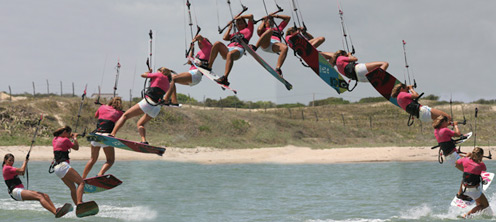
Best Tips
Bring your front foot all the way the landing event. Landing toeside paves way to complete a front loop. Your shoulders need to turn so that facing forward will not be hard, so go for the full rotation even though it may not look like one.
Common Problems
1. Getting your body to toe side needs a lot of effort at first because you are trying to twist your back shoulder past the bar and the chicken loop. The solution is to keep pulling right up to the bar and let the kite do the work.
2. Performing the toe side can be very delicate at first attempt, so focus on pulling the diving kite at the landing position and control your shoulder back for the rotation. Once you have your mind and body in a perfect state, this should be easy.
Key Points
1. Send the kite
2. Throw the rotation
3. Keep back leg straight
4. Pull front leg under your buttock
5. Dive the kite hard
Here´s what it should look like in real time!
Blind Judge
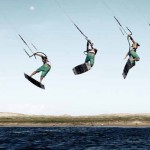
Blind Judge

Simple but great and definitely one of the fundamentals that you have once nailed, this trick rewards you with a high percentage return rate. Blind Judge is an extension of the raley to blind because it needs accuracy, elevation, kite control and enough power. The Blind judge is an unhooked raley to blind but with an air pass rather than a surface pass.
Ironing out the blues
In preparation to the blind judge technique, you need to practice kite control, the take-off and the authentic raley. In all pass moves, kite control is vital. Too high will result to difficult pass, too low and it becomes too typical. Position yourself to get sufficient height and power to give you an enough forward momentum, so it will be a soft touch when you land the kite.
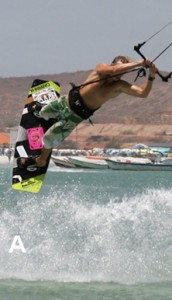 Pic A – We see the surfer is practicing for the Blind Judge. It’s pretty simple to see that it is not a raley. Position with both legs parallel to the water, but the surfer carved the board up into the wind and underneath, so it flicked around.
Pic A – We see the surfer is practicing for the Blind Judge. It’s pretty simple to see that it is not a raley. Position with both legs parallel to the water, but the surfer carved the board up into the wind and underneath, so it flicked around.
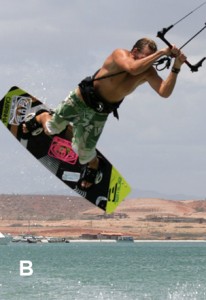 Pic B – The surfer paused in the raley just before passing. Let’s have a brief rationalization at the strong points of this position.
Pic B – The surfer paused in the raley just before passing. Let’s have a brief rationalization at the strong points of this position.
• Beginning with the feet, we can see that the front foot is high. This is the foot that needs to come through because of its height, it can keep up longer and will not drag the surfer away from the bar.
• The same goes with the front knee, just like the back knee in a shifty, this position can swing the surfer through with a swift power, and it will keep the surfer up plus it will come around the surfer’s body because of the high spacing.
• The surfer has pulled-in hard with both hands and tries to the head over the bar, so the force will move forward. It will be difficult if the kite is too high.
• Lastly, if we look at the hands and the bar, as a result to the surfer’s body position, it is already in a twisting position preparing where it will land and make the pass much easier.
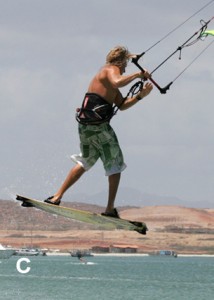 Pic C – Is the result of all the good work in the previous pictures. As the back hand has been released, the head is above the bar preventing to go too far even if the surfer drops. The front wrist and arm are twisting already, so that it will allow the surfer to spin early. The front knee has swung around and under the bar, giving the surfer the drive to turn all the way while bringing the body under the bar. Finishing point here is that if the kite is well positioned and not too low, the surfer can pinch down a bit to make the pass easier.
Pic C – Is the result of all the good work in the previous pictures. As the back hand has been released, the head is above the bar preventing to go too far even if the surfer drops. The front wrist and arm are twisting already, so that it will allow the surfer to spin early. The front knee has swung around and under the bar, giving the surfer the drive to turn all the way while bringing the body under the bar. Finishing point here is that if the kite is well positioned and not too low, the surfer can pinch down a bit to make the pass easier.
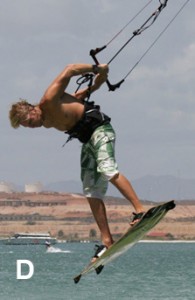 Pic D – The moment of truth! Firstly, releasing the back hand late is wise because it was nearer from the body and therefore it is not too far to grab the bar on the other side of the surfer.
Pic D – The moment of truth! Firstly, releasing the back hand late is wise because it was nearer from the body and therefore it is not too far to grab the bar on the other side of the surfer.
Secondly, because the surfer’s wrist, arm and bar were already twisting, the surfer has got the bar around and ready to grab quickly.
Thirdly, due to the emphasis on getting the head over the bar, the front leg of the surfer is high and swings the body under the bar.
Lastly is to hold on with your hand until the back hand can grab the bar. You need to rotate far enough to grab the bar behind you. And timing is the key to success in this move.
Step by Step Sequence (in Summary)
1. – With the kite around 1 o’clock combined with sufficient speed, the surfer has gone off to the wind unhooked and carves hard upwind, a full kite face and very straight front leg.
2. – As the board turns underneath, the surfer explodes up off his rear leg and allows the shoulders and bar to turn with the legs.
3. – A moment after the take-off, the surfer is in full momentum upwind, stretched out and ready to swing everything through.
4. – After gaining the elevation, the surfer starts the rotation to blind, pulls hard with both hands and aims to pull them all the way to the right buttock. At the same time, the surfer pulls the right leg up aiming to bring the knee up to the hands.
5. – As the body swings towards the kite, the surfer pulls his head up over the bar and started to twist the bar and turn his body into the rotation. Keep both hands on the bar always.
6. –Release the back hand and turn the head down around.
7. – With the bar already set and waiting, the surfer reaches behind the back and grabs the bar with the other free hand.
8. – As you drop, in order to put weight over the feet, go with your old front hand and lift your head.
9. – The surfer will land and ready to absorb the impact with both legs. Once the surfer is stable, a slide back to heel side move is easy, carve around to heel side, pop back to heel side or rid out toe side. If you really want to show off, then go for the pop to wrapped from toe side!
Important Reminders
1. Carve long upwind
2. Body, chest and bar upwind
3. Pull with both hands down the buttocks
4. Turn head before releasing back hand
5. Hold on tight
Jesus Walk
Jesus Walk
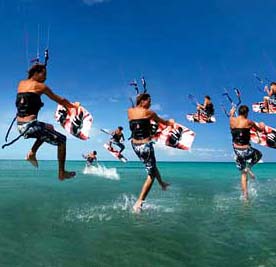 Jesus Style or Jesus Walk, the trick’s name catches your attention, well, we all know kiting is the sport of the gods so are you surprised? Perhaps after doing the trick successfully, you can now turn water into wine. Jesus Walk trick is the kiteboarding equivalent to the “Christ Air” in Skateboarding. Darkslide trick, being a pre-step to another cutting edge kitesurfing trick that is to be discussed here, must be performed smoothly before any Jesus Walk attempt. Darkslide and Jesus Walk are all about Hangtime, but instead of Boost it is almost a hangtime, like a walk above the water.
Jesus Style or Jesus Walk, the trick’s name catches your attention, well, we all know kiting is the sport of the gods so are you surprised? Perhaps after doing the trick successfully, you can now turn water into wine. Jesus Walk trick is the kiteboarding equivalent to the “Christ Air” in Skateboarding. Darkslide trick, being a pre-step to another cutting edge kitesurfing trick that is to be discussed here, must be performed smoothly before any Jesus Walk attempt. Darkslide and Jesus Walk are all about Hangtime, but instead of Boost it is almost a hangtime, like a walk above the water.
Ponder on you first attempt to Boost that you just could not get the right height and you simply looked like doing the basics of just swinging under your kite. Well that is just exactly what you are attempting to do with a Darkslide or Jesus Walk. A lot of kitesurfers have not done this latest tricks yet, never have even attempted in mind because of its timing difficulty. Others would tend to ride with their feet locked in so tight that there’s no way they could get the board on and off so easily. Practice makes perfect because quitters do not win and winners do not quit.
What’s the common question a sport enthusiast would ask of this trick? “Do you let your kite loop at the end,or catch it before it loops back to the left and fly it normally?” The answer is actually shown in the actual videos I have provided in this page. Since this is a newly developed trick, I will not go into further details but the keystones and tips for you to consider if you will try to do it first time. Let experiences of kitesurfers speak for the trick. The video likewise has so much to say about this particular trick.
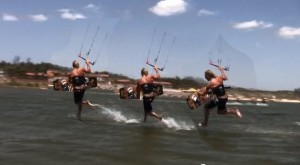 Highlights of the Trick
Highlights of the Trick
Jesus Walk trick does not work underpowered or too over-powered, so make sure just to have enough power in your kite just before the zenith. Ride with your normal speed.
Steer your kite slowly from left to right. Instead of steering the kite back before landing, you pull harder to the right.
When the kite starts to make a kiteloop, you put your feet back on the board. (Of course, by now you already know how to kiteloop, it’s the fundamental trick you learned first in this kind of sport.)
Pop off the water and grab your board while holding down the bar to stay in the air. Do as many steps in the water as possible while you steer the kite slowly over the zenith.
Get back into the straps, but meanwhile keep pulling the kite hard to make it loop, so you get some extra airtime. Land and keep riding.
Best Tips
Doing a kiteloop instead of a transition makes it easier. For a transition, the timing has to be perfect. Less perfect with a kiteloop gives you a bit more time to get back into the straps. The landing will be faster though.
Steer the kite to 11 o clock, then pop off the water, while you pull off the board. Slowly steer the kite back to 1 o clock position while you run over the water. When the kite reaches 1, do the kiteloop. Then put your board back on and land.
To add more power in the kite to stay up in the air, pull the bar in so the kite loops.
You need space; with someone close by you cannot loop the kite.
Be quick with putting that board back on to concentrate on the landing.
